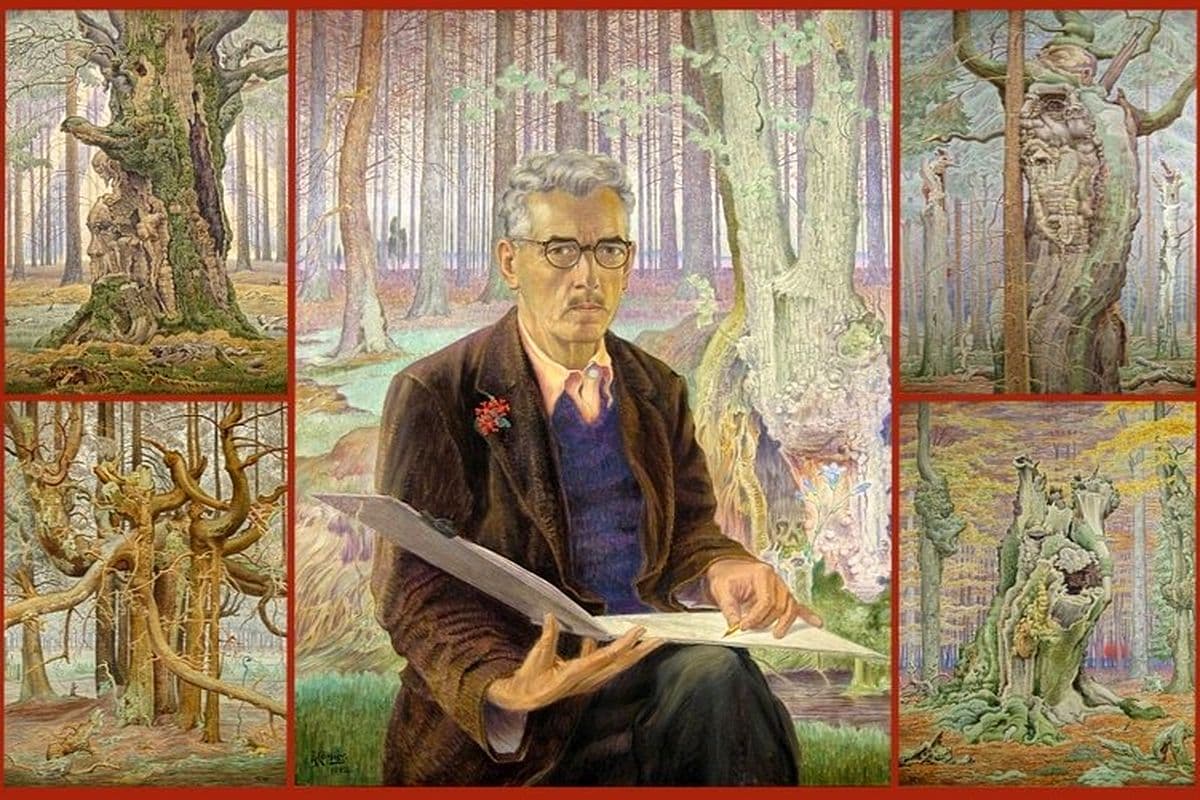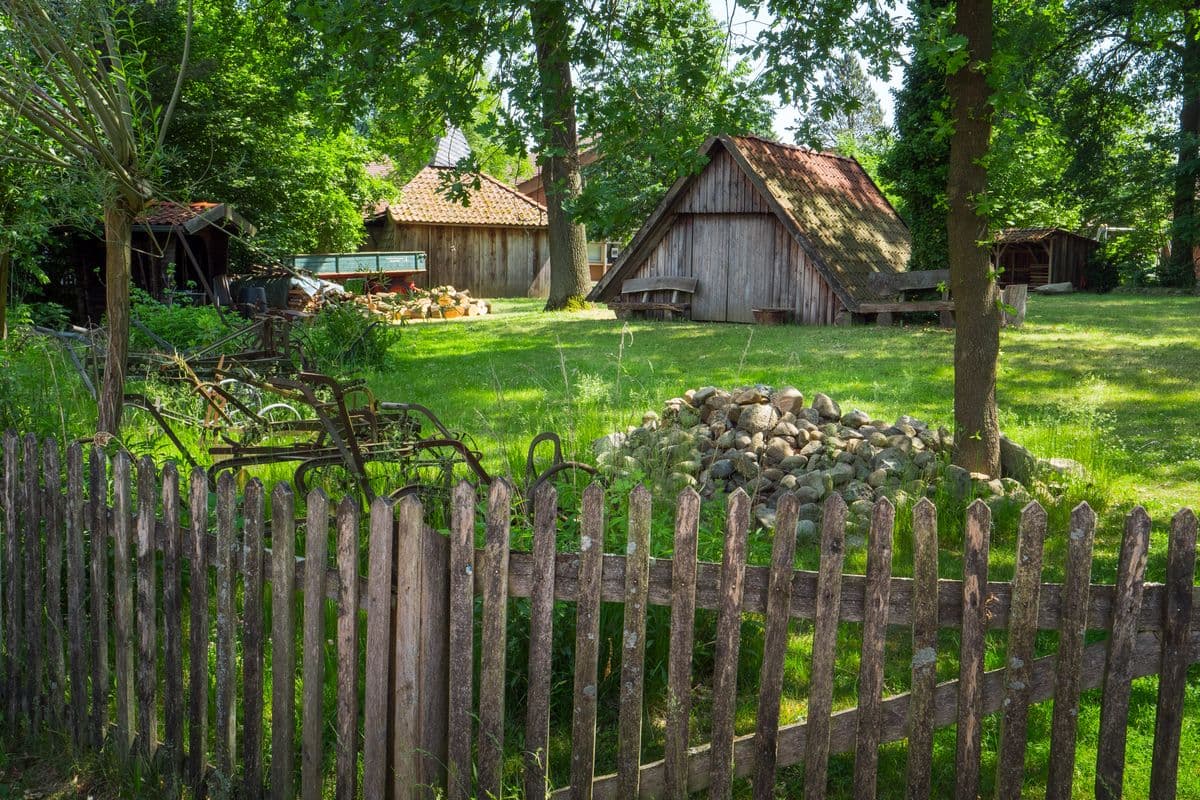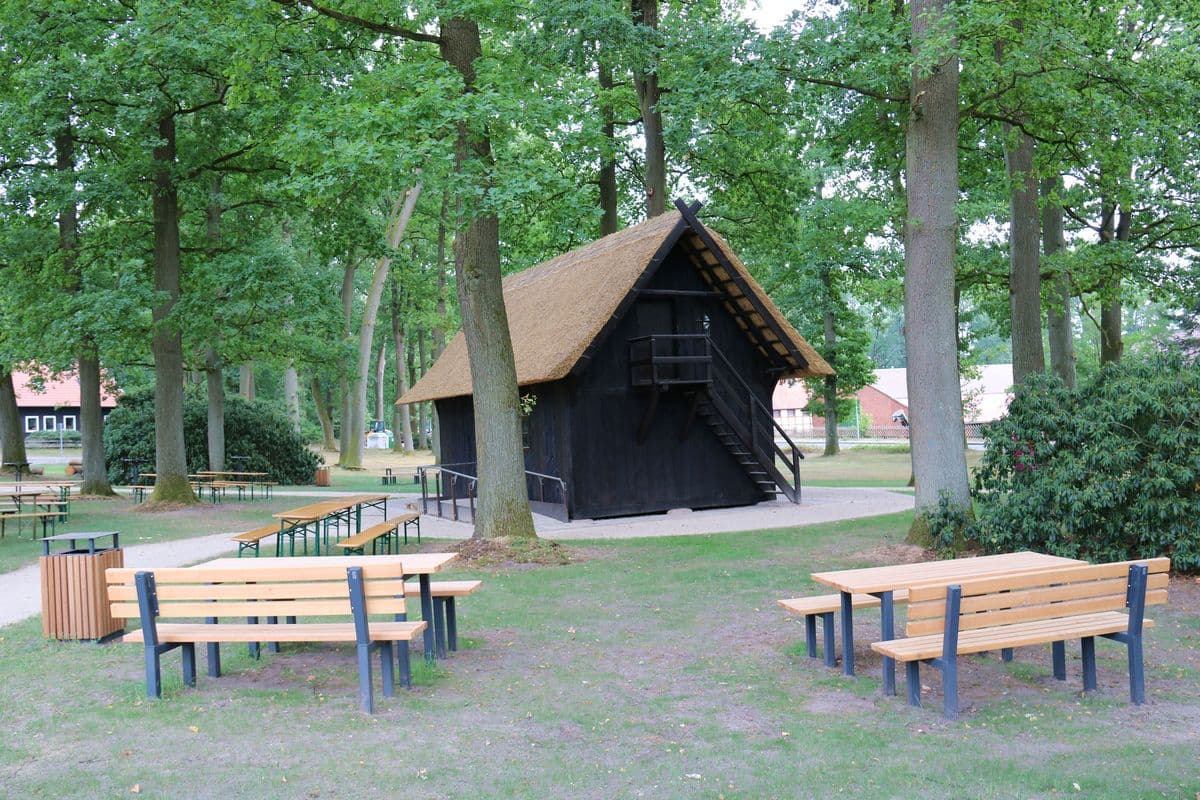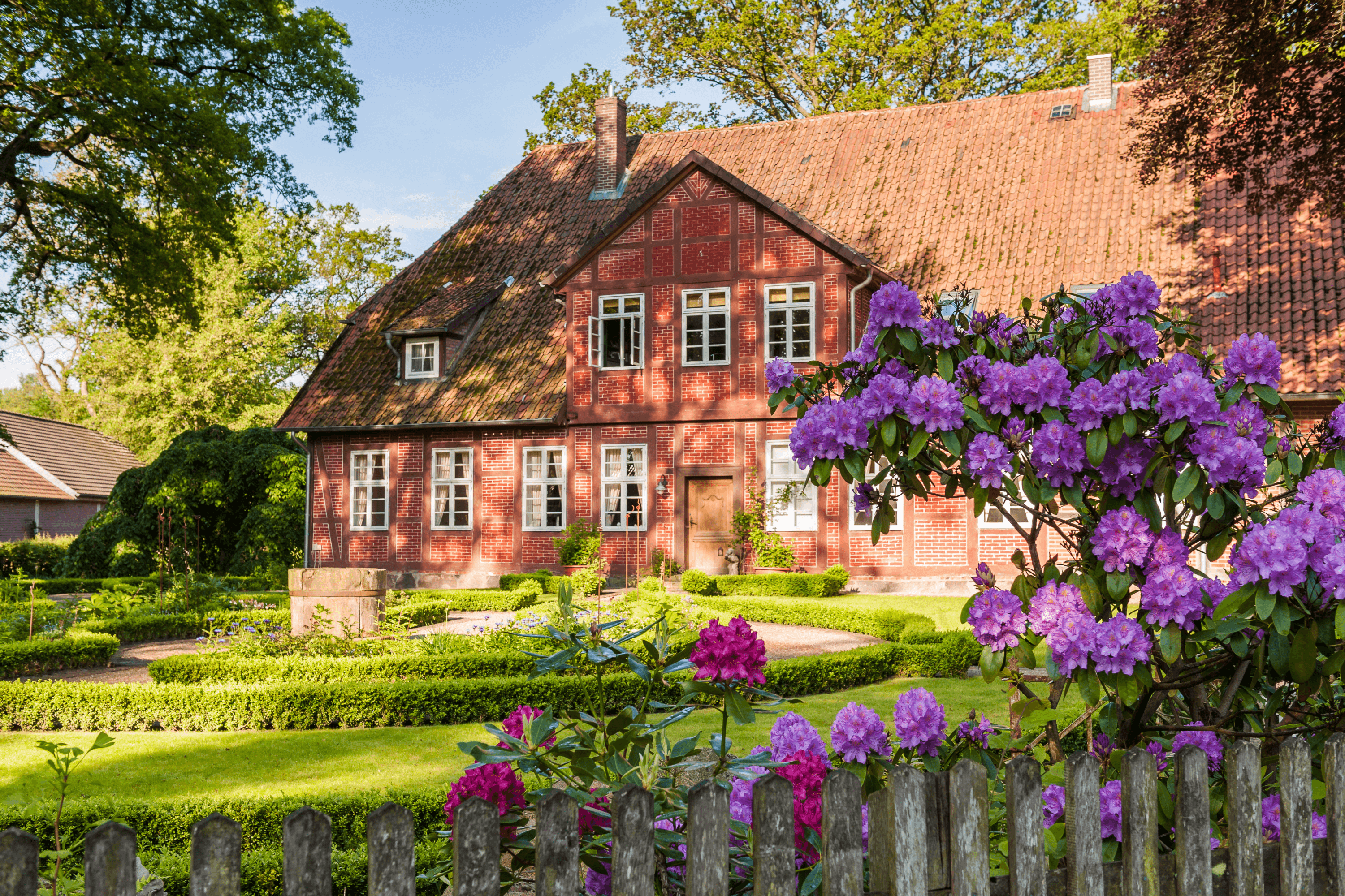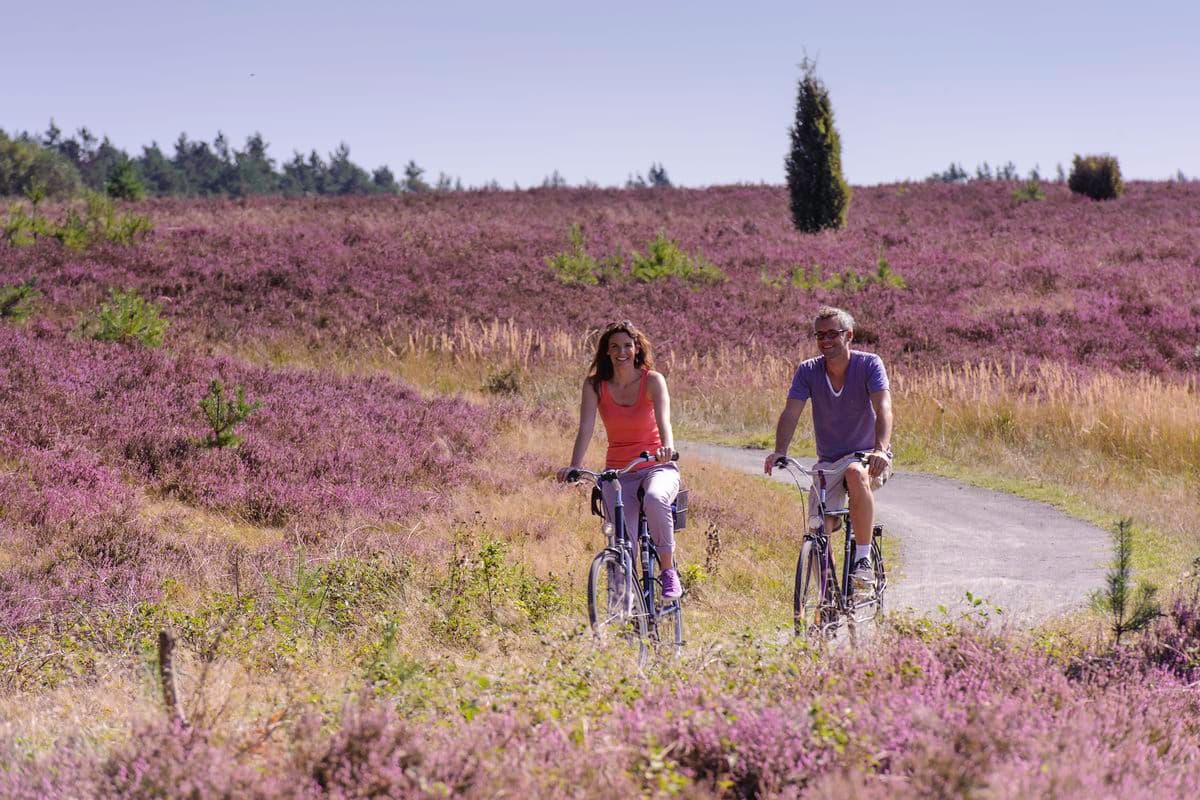
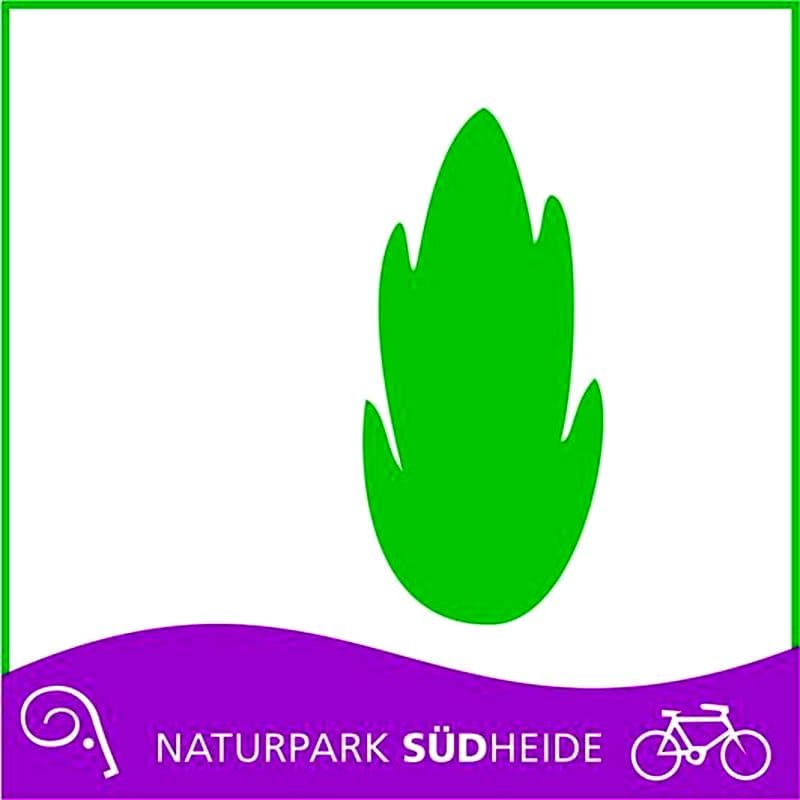
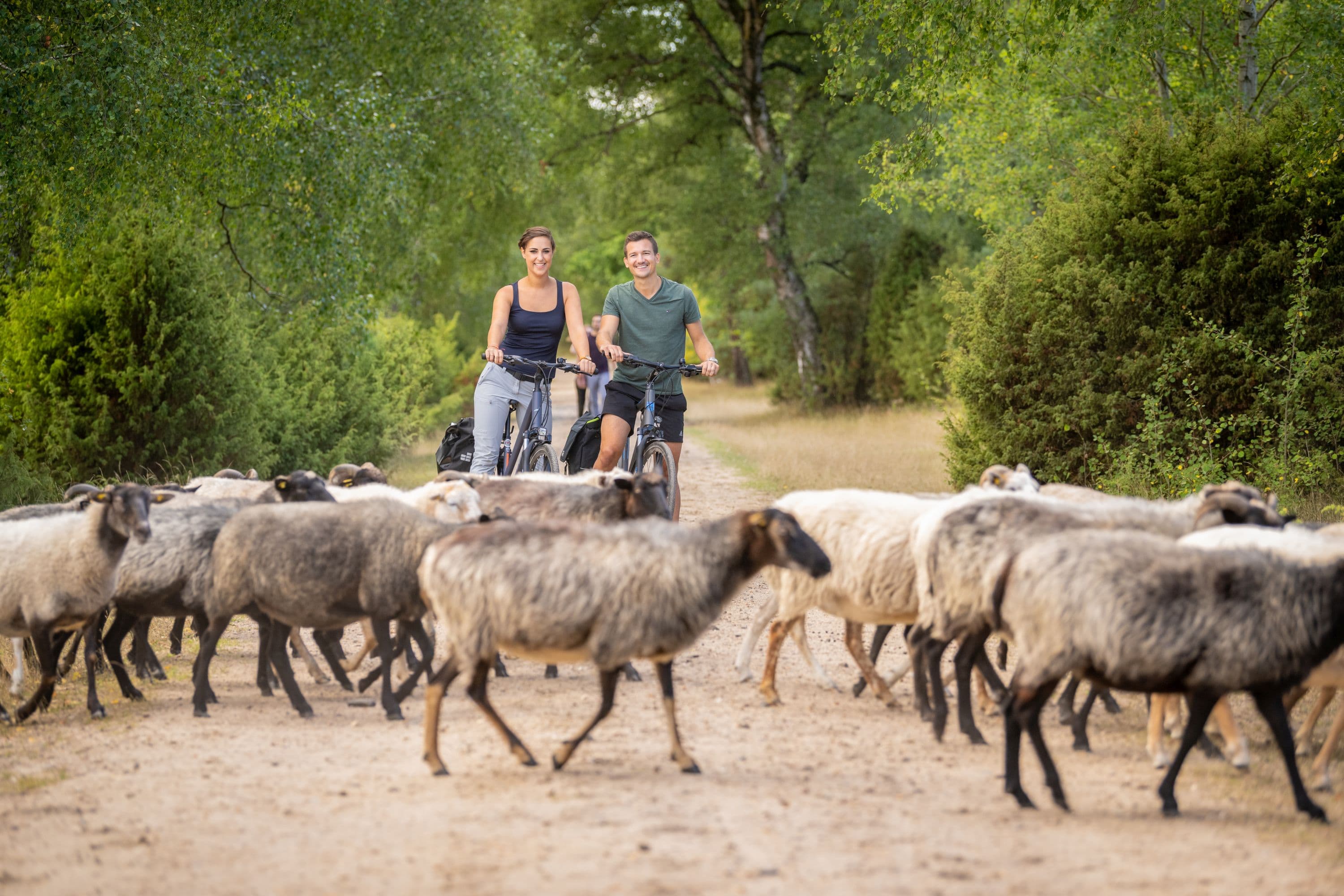
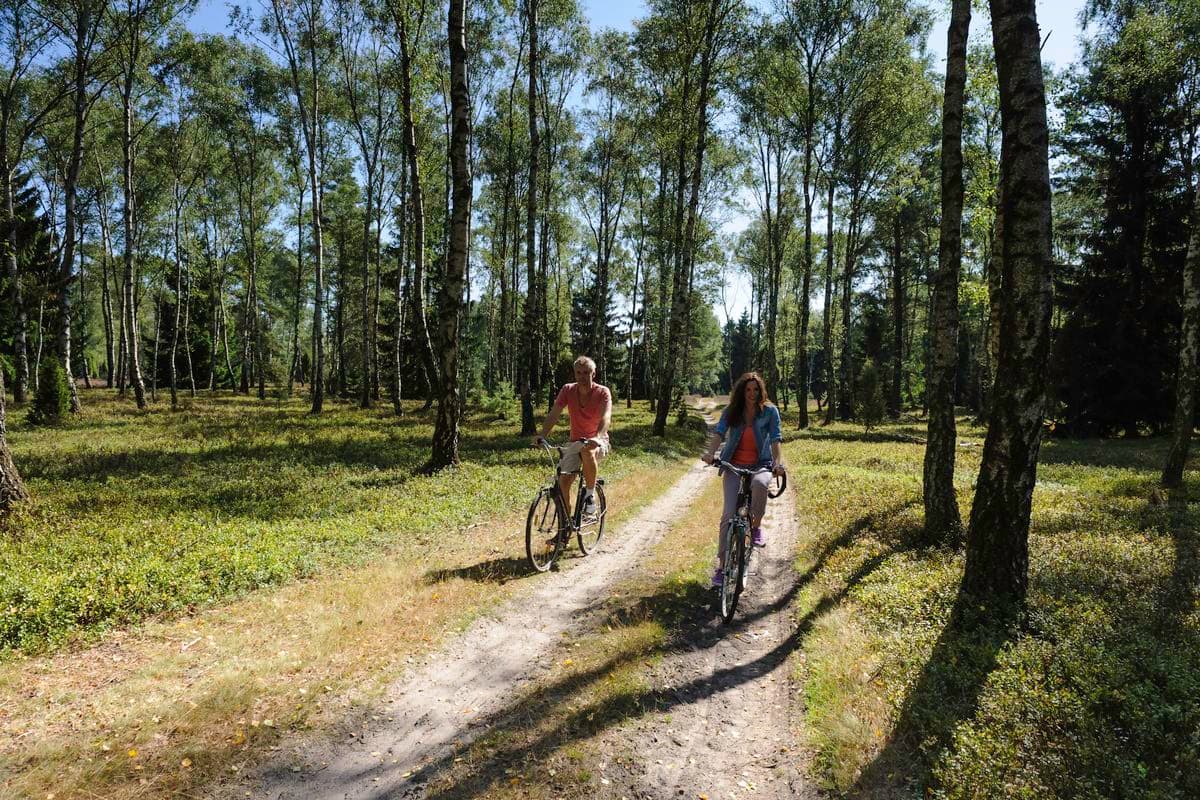
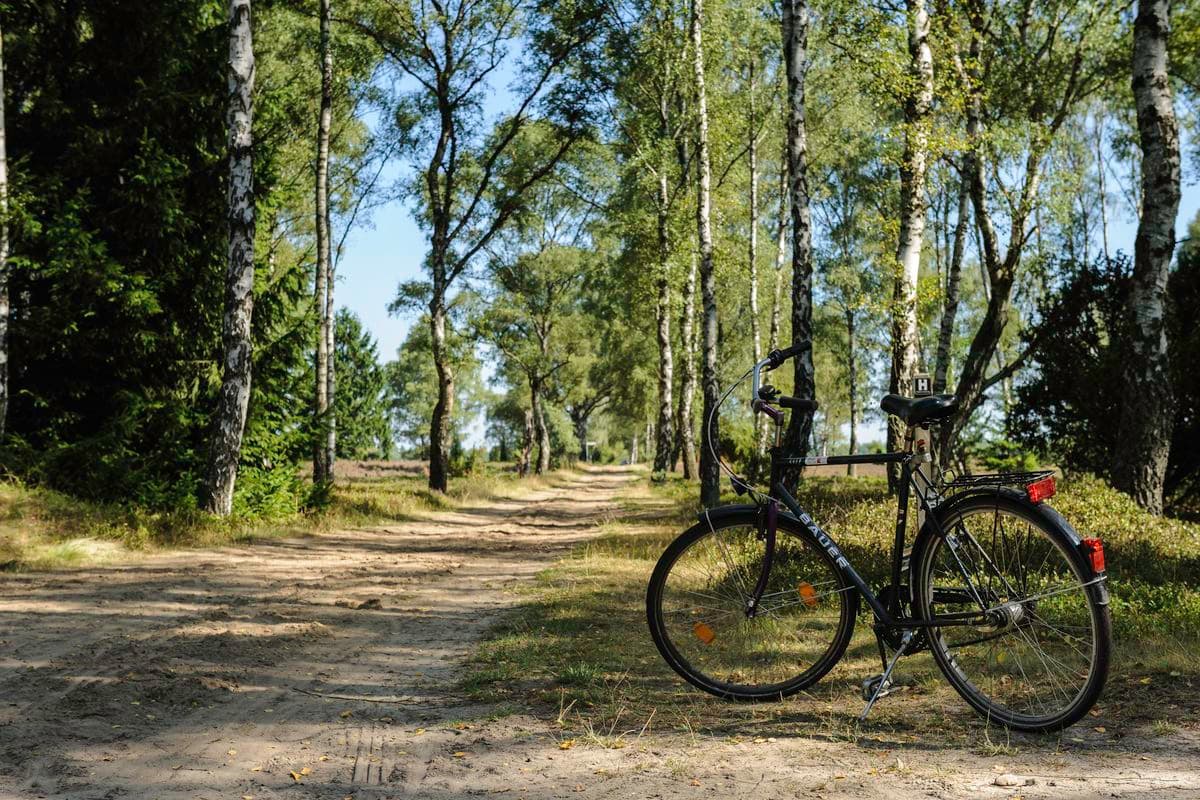
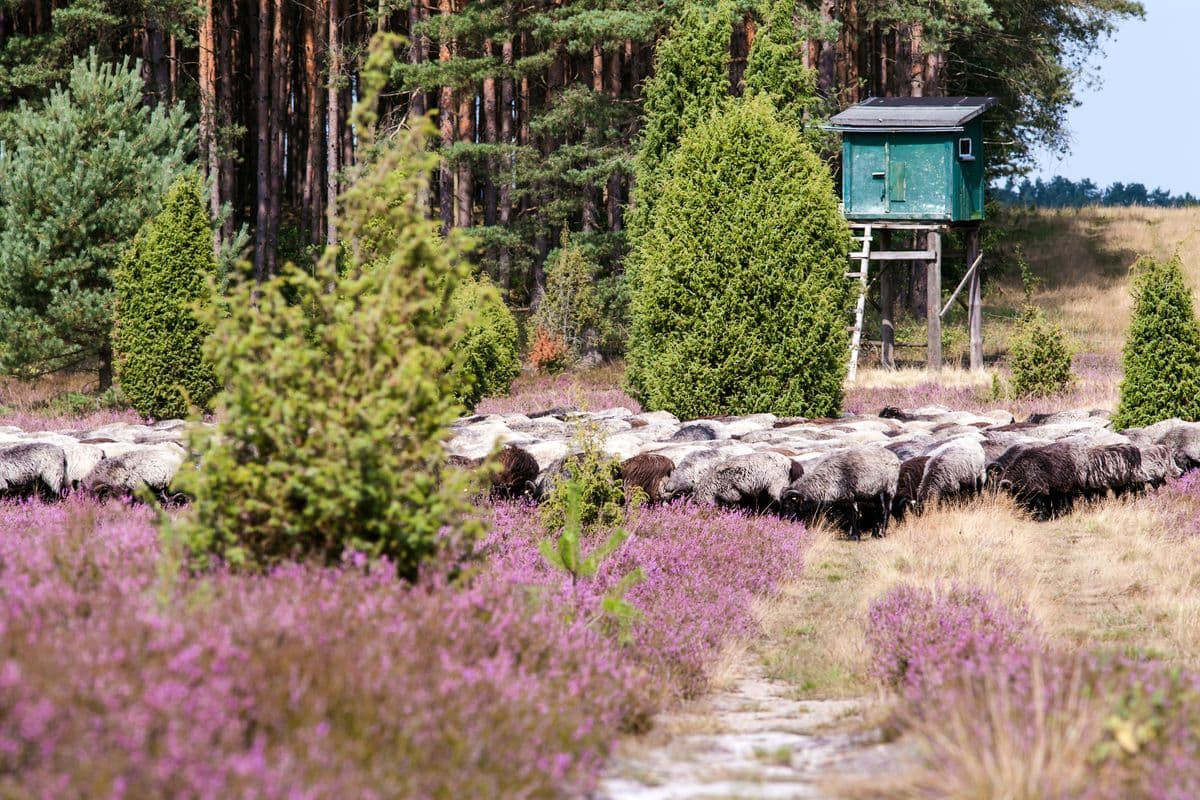
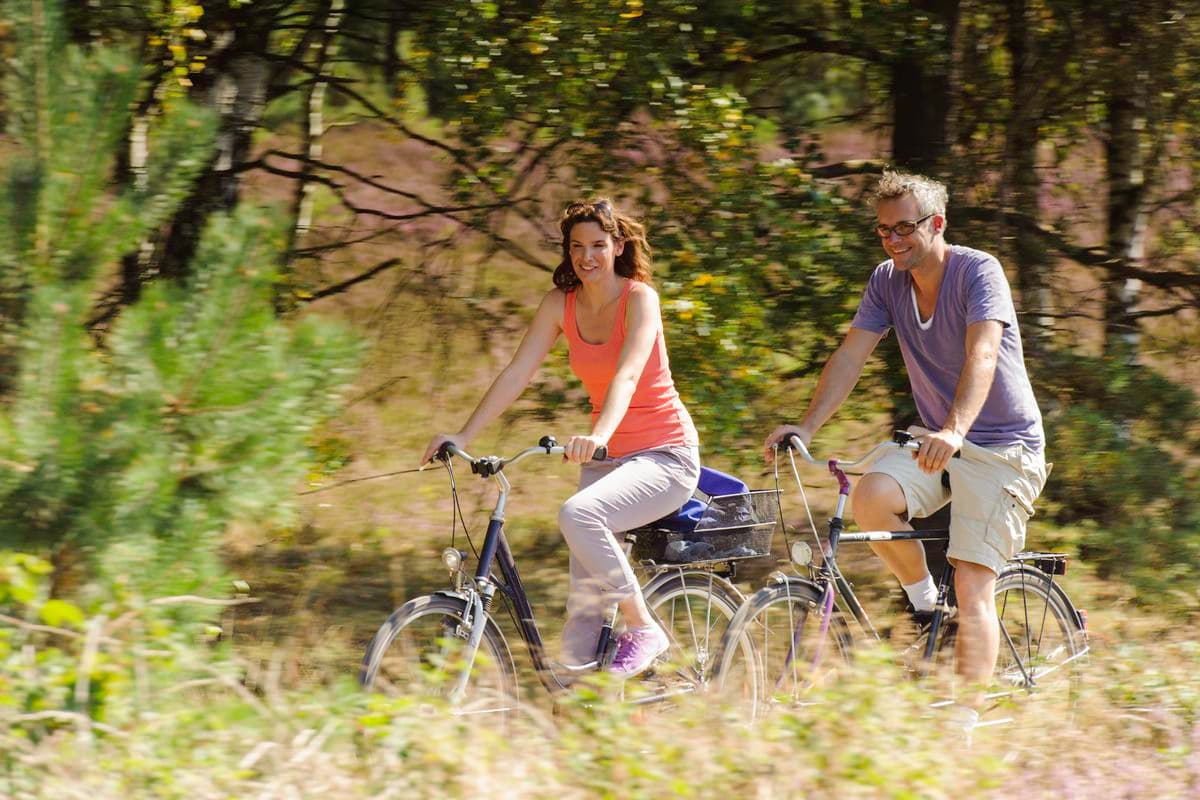

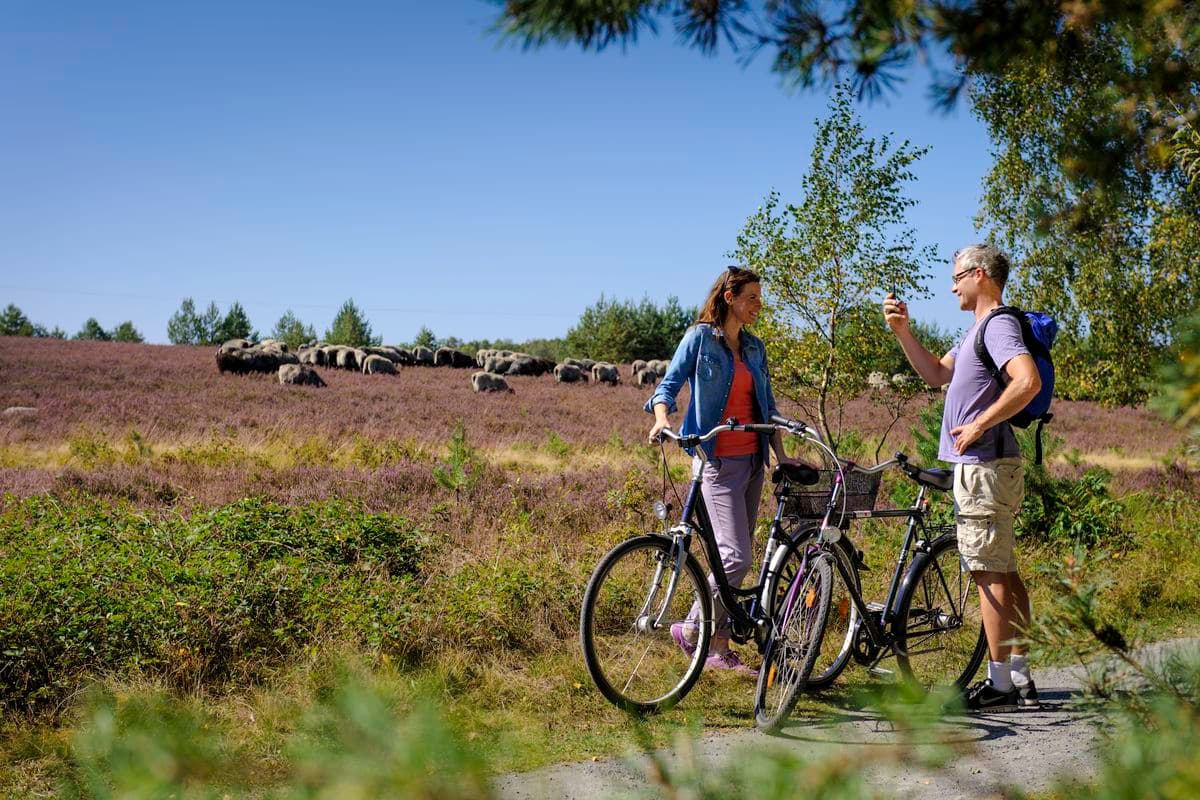
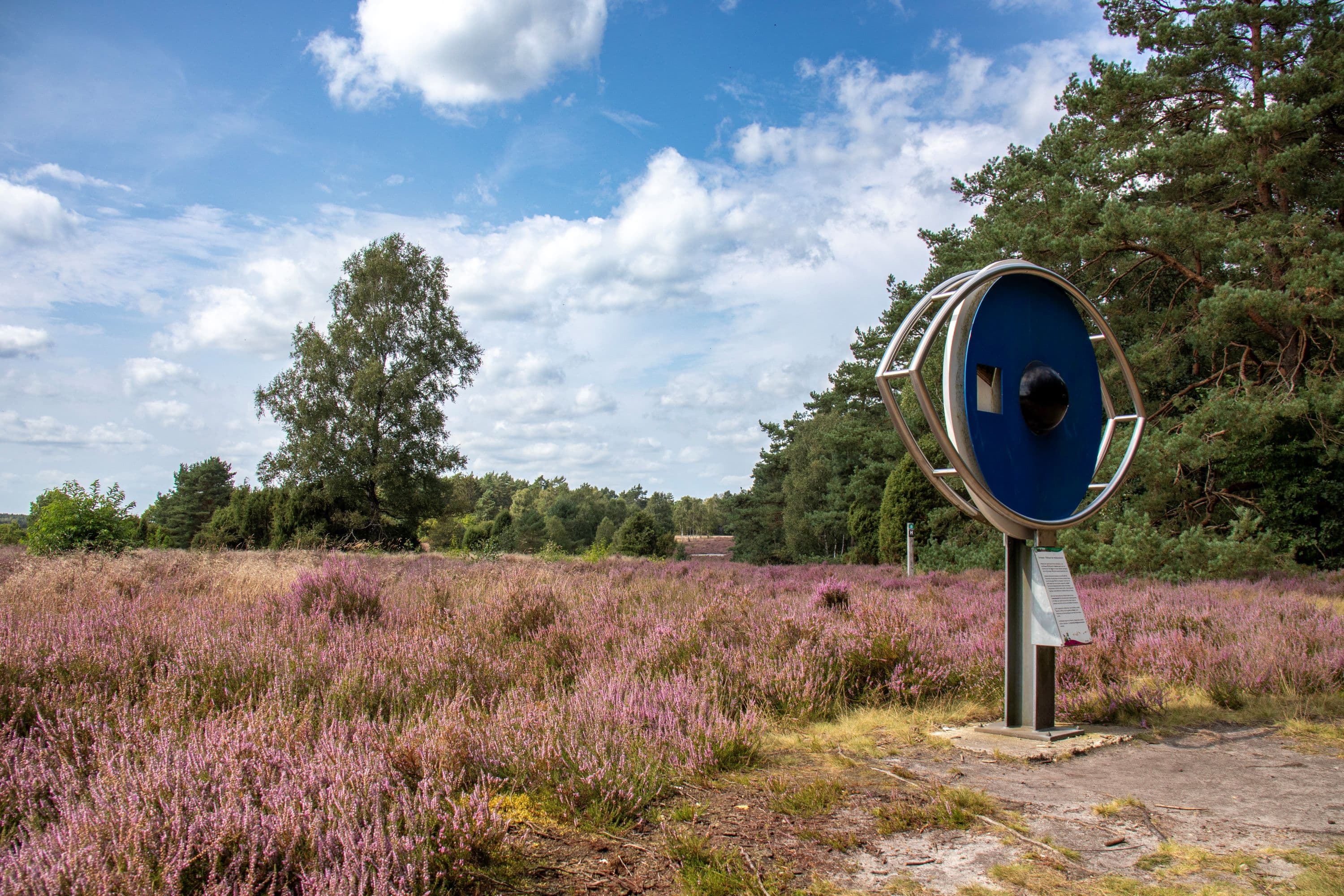
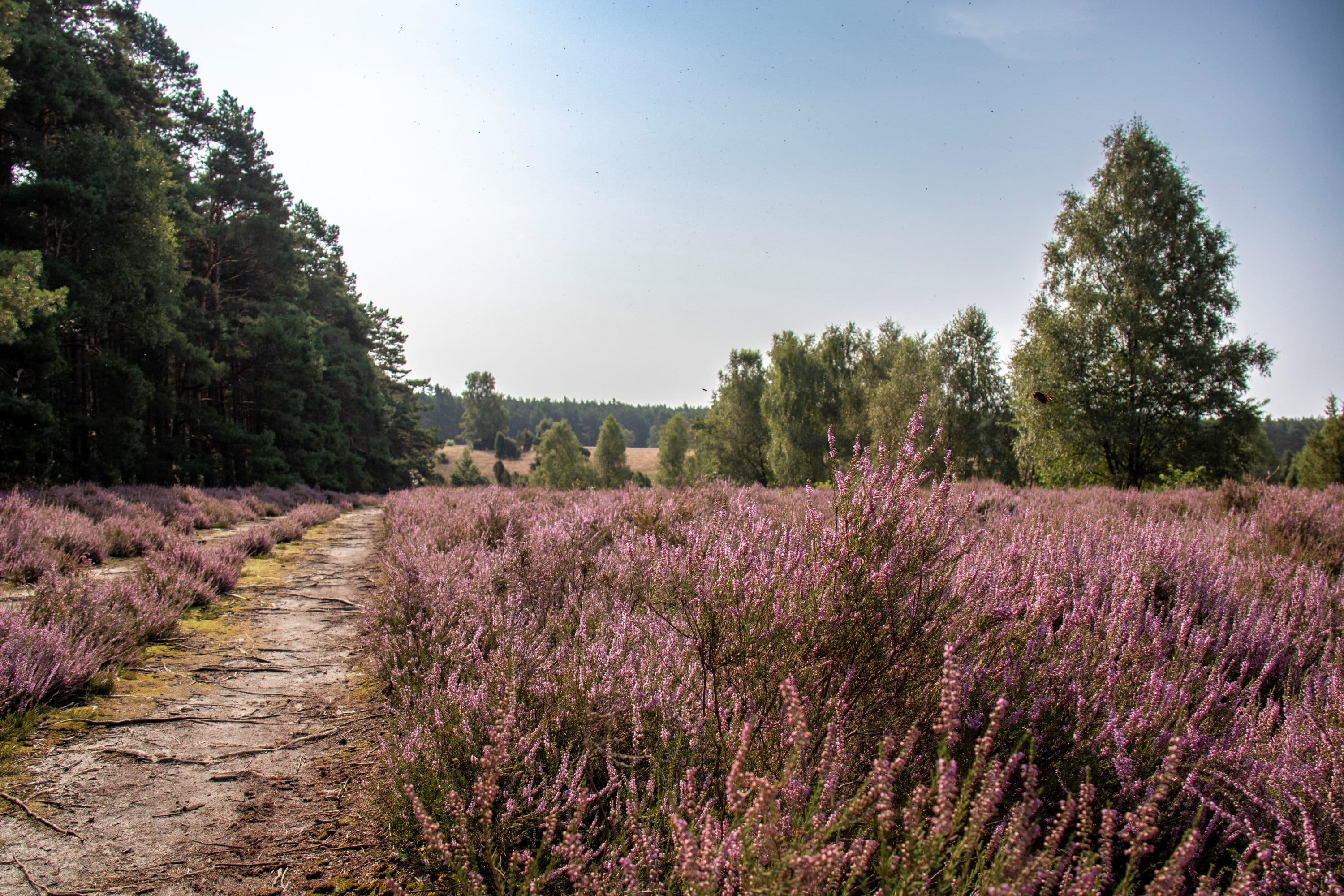
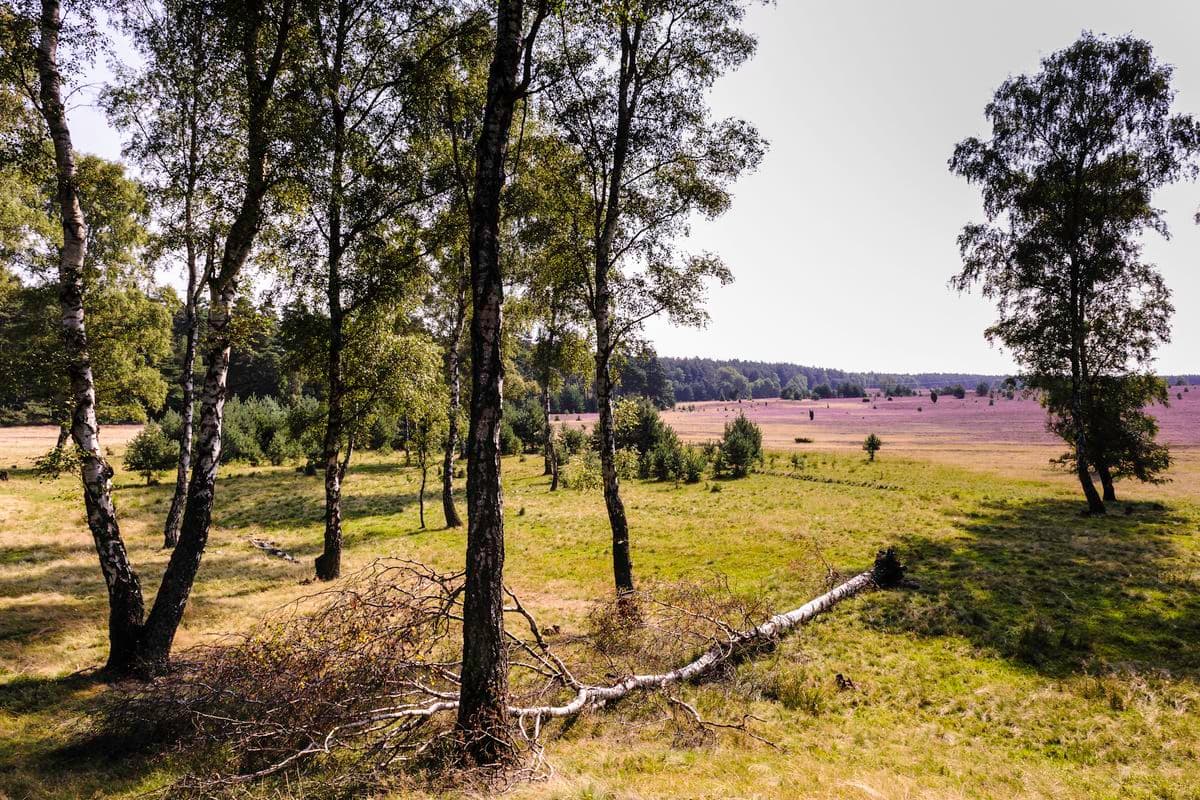
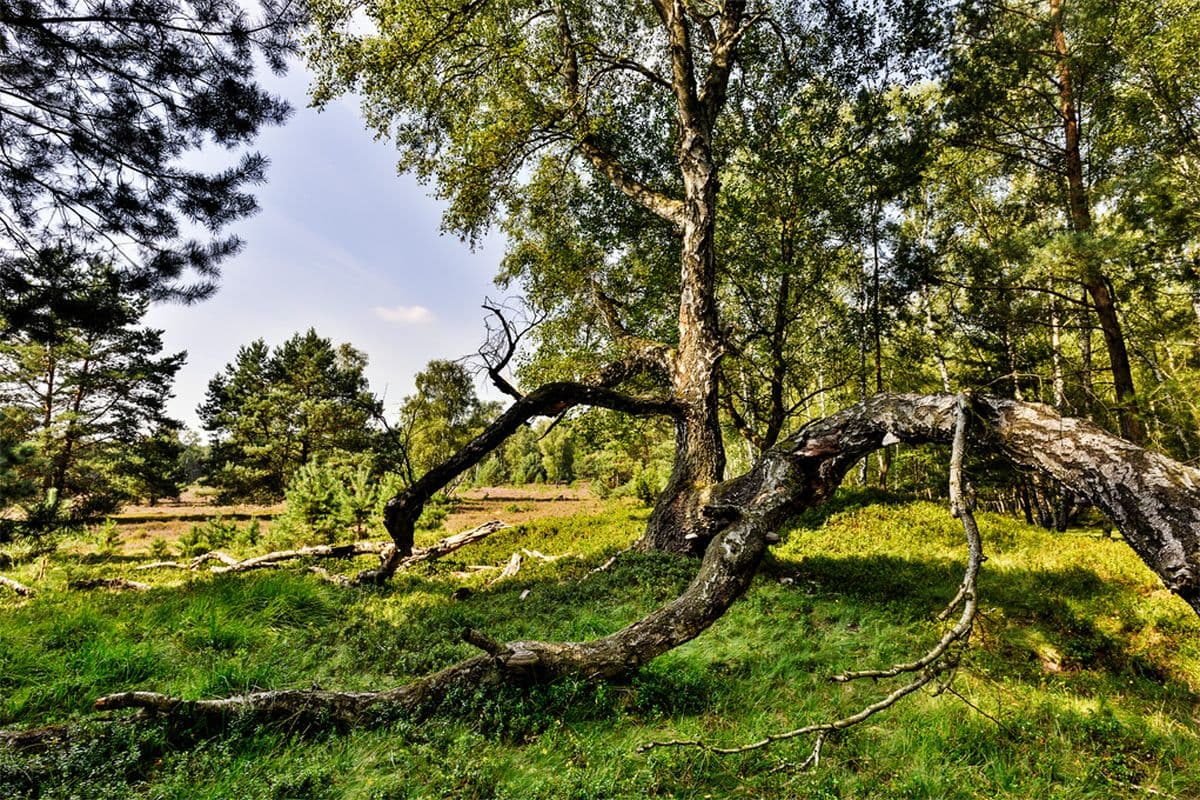
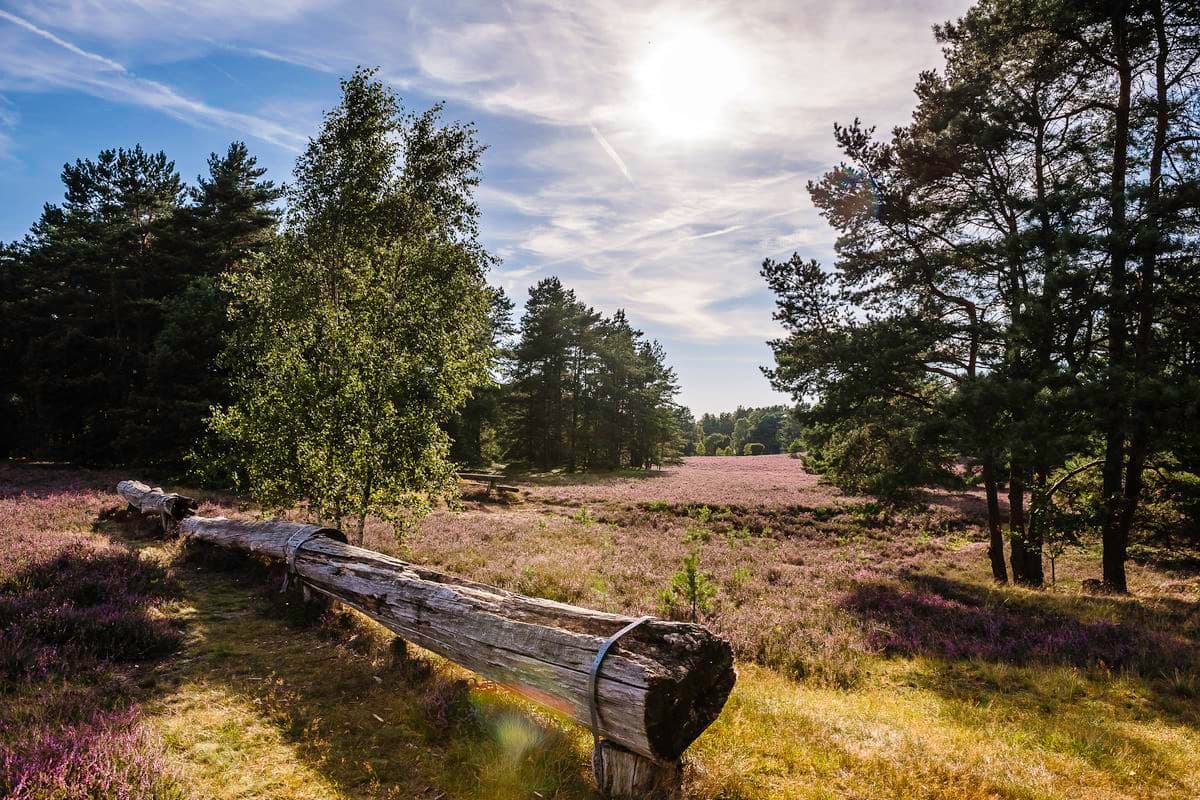
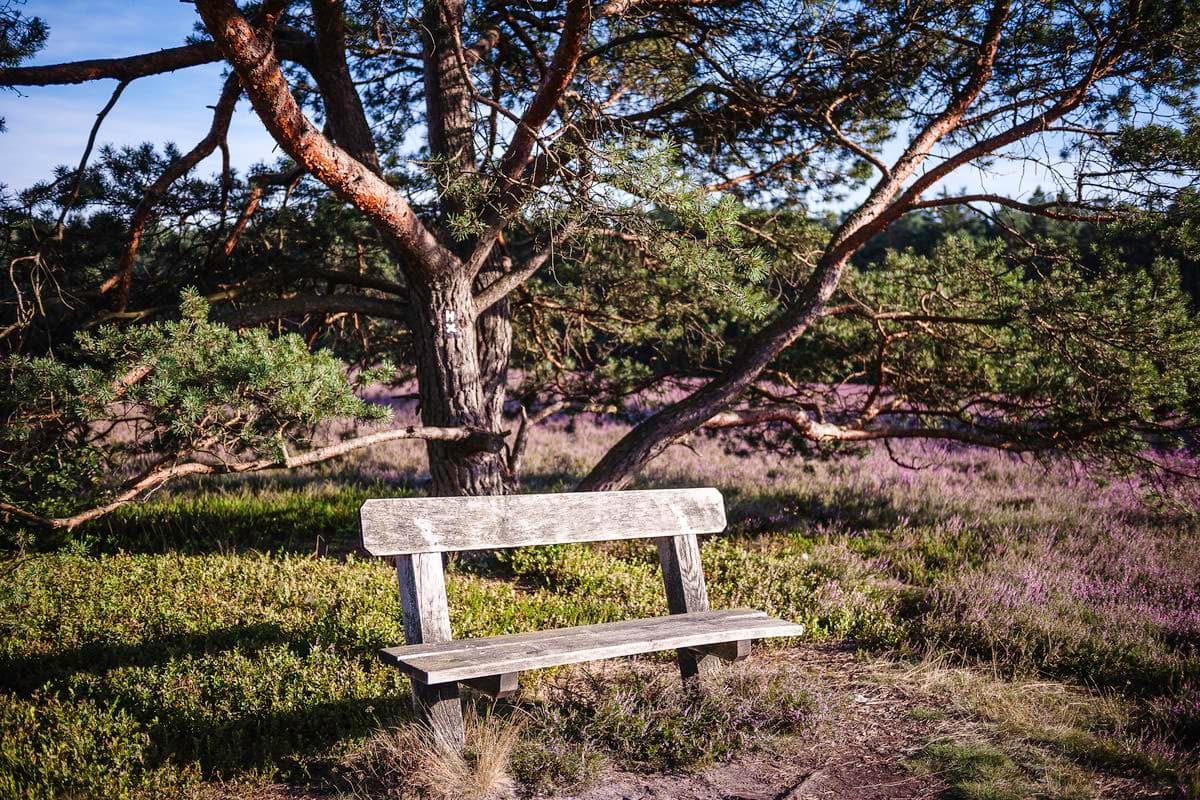
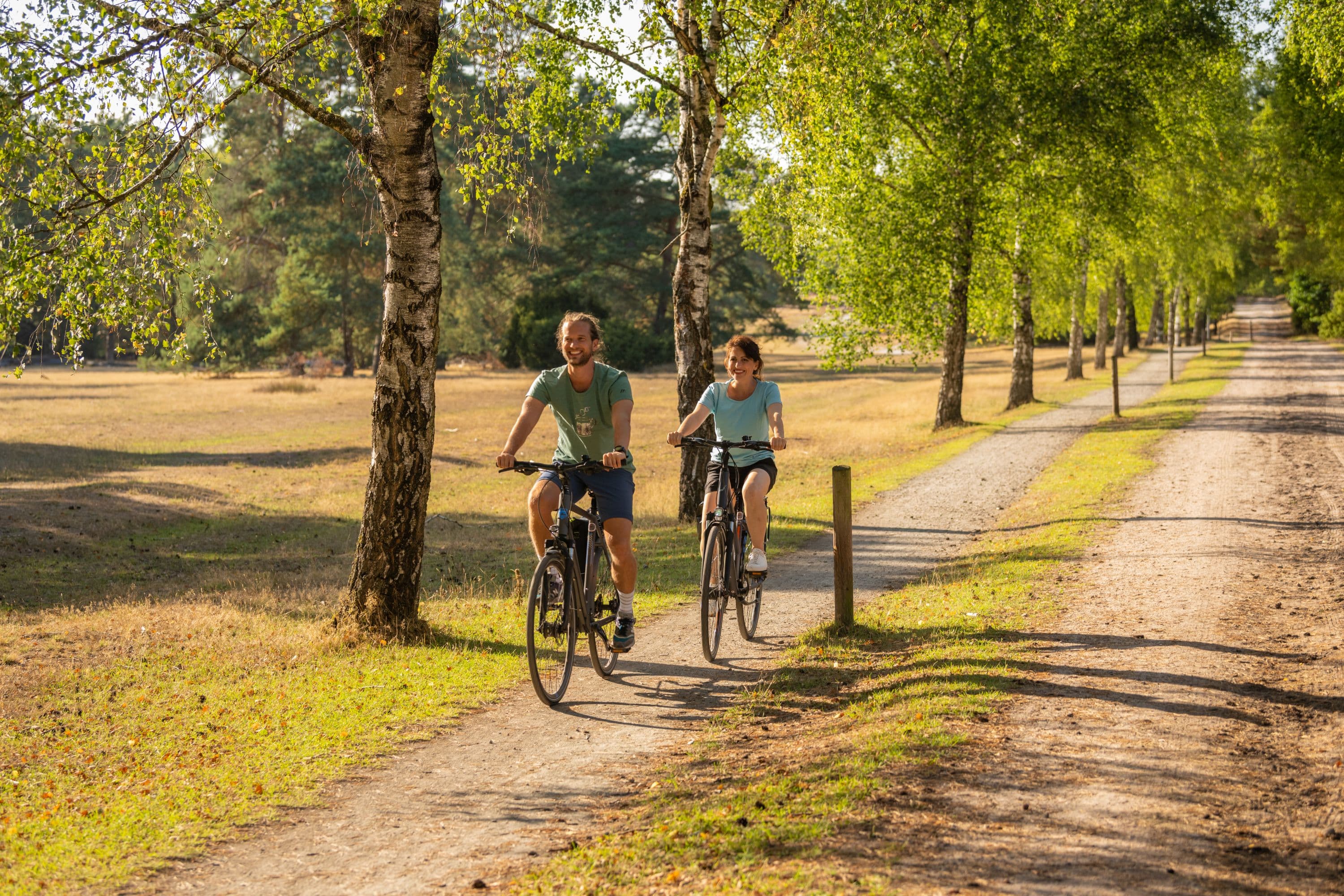
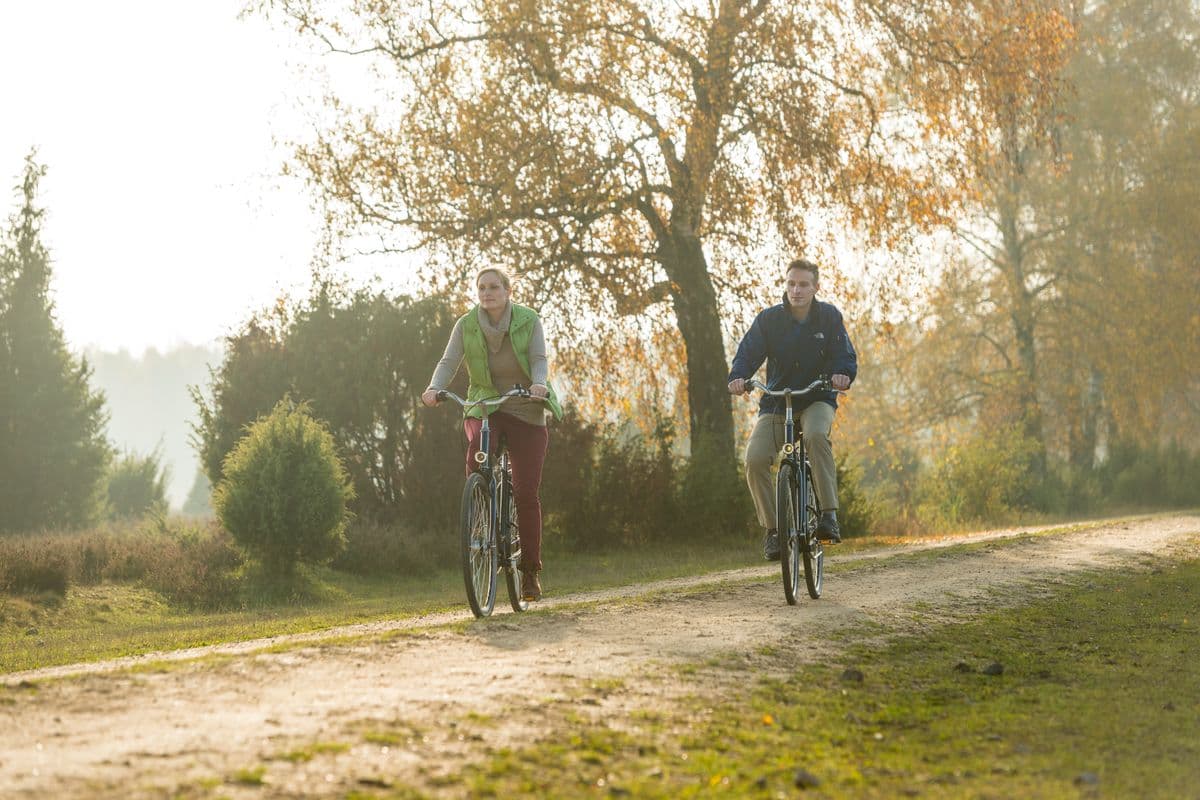
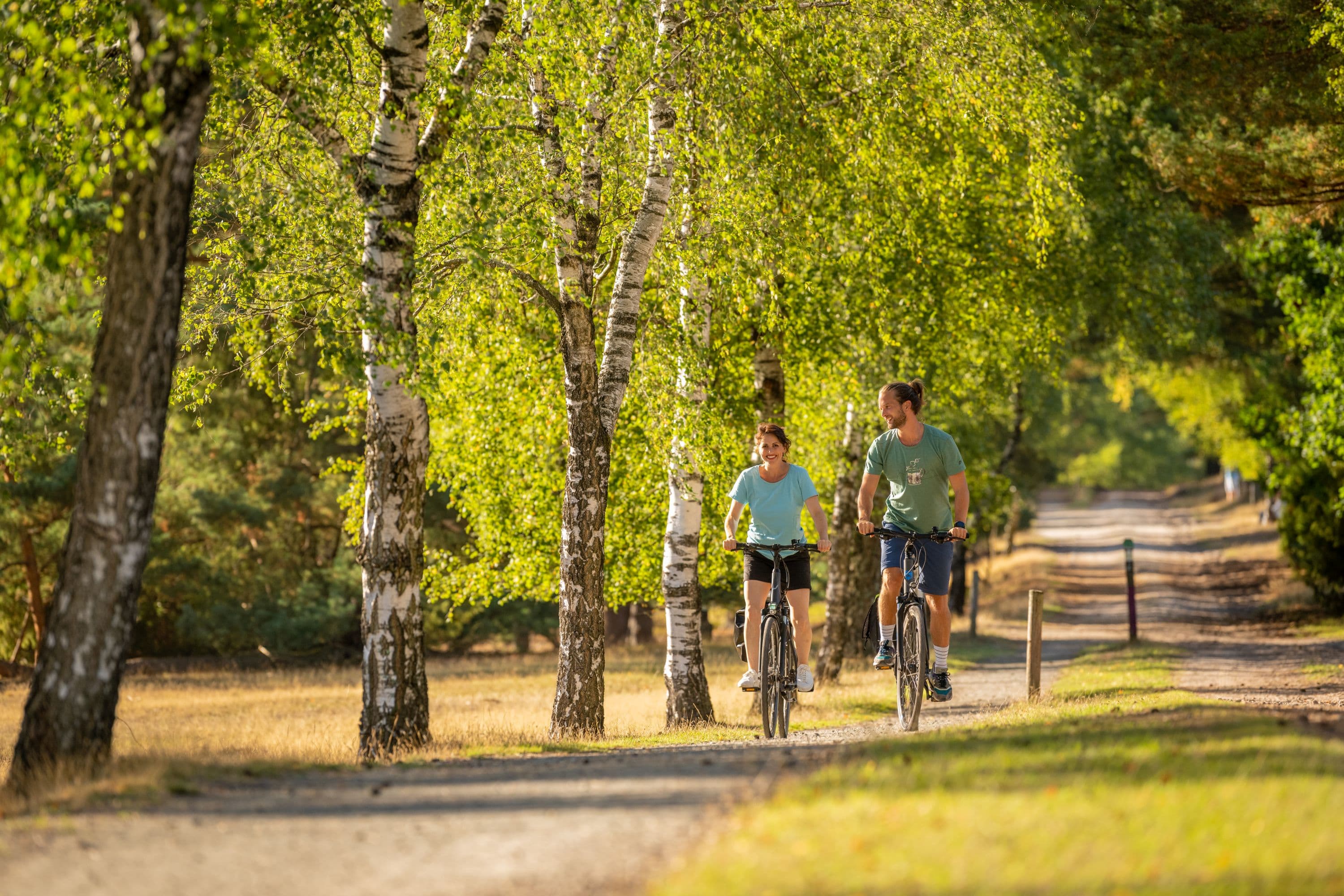
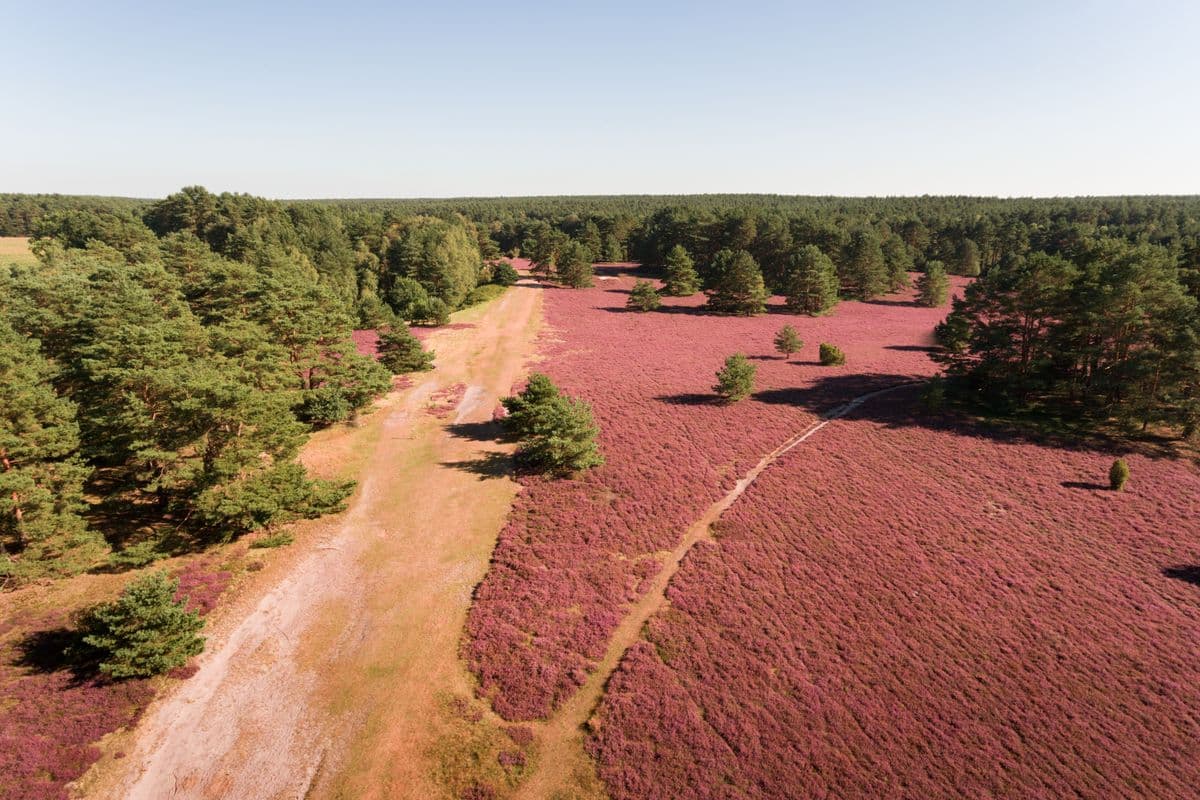
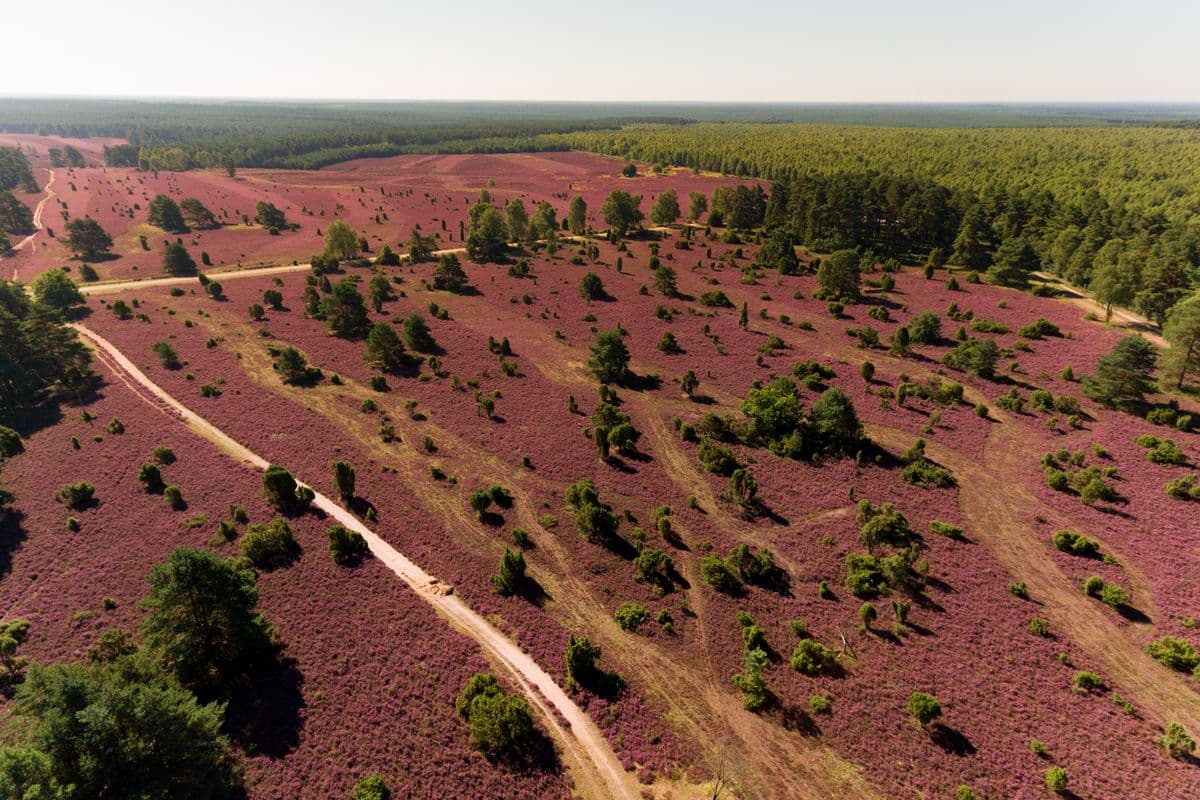
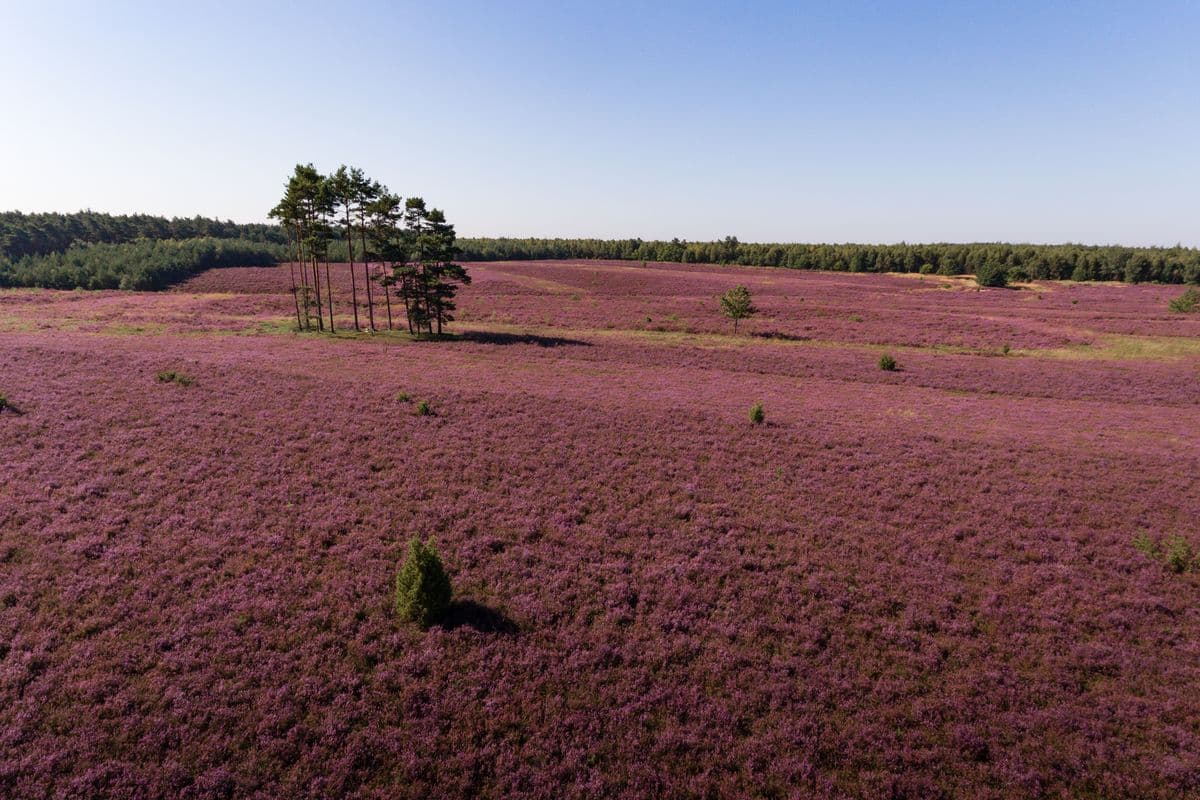
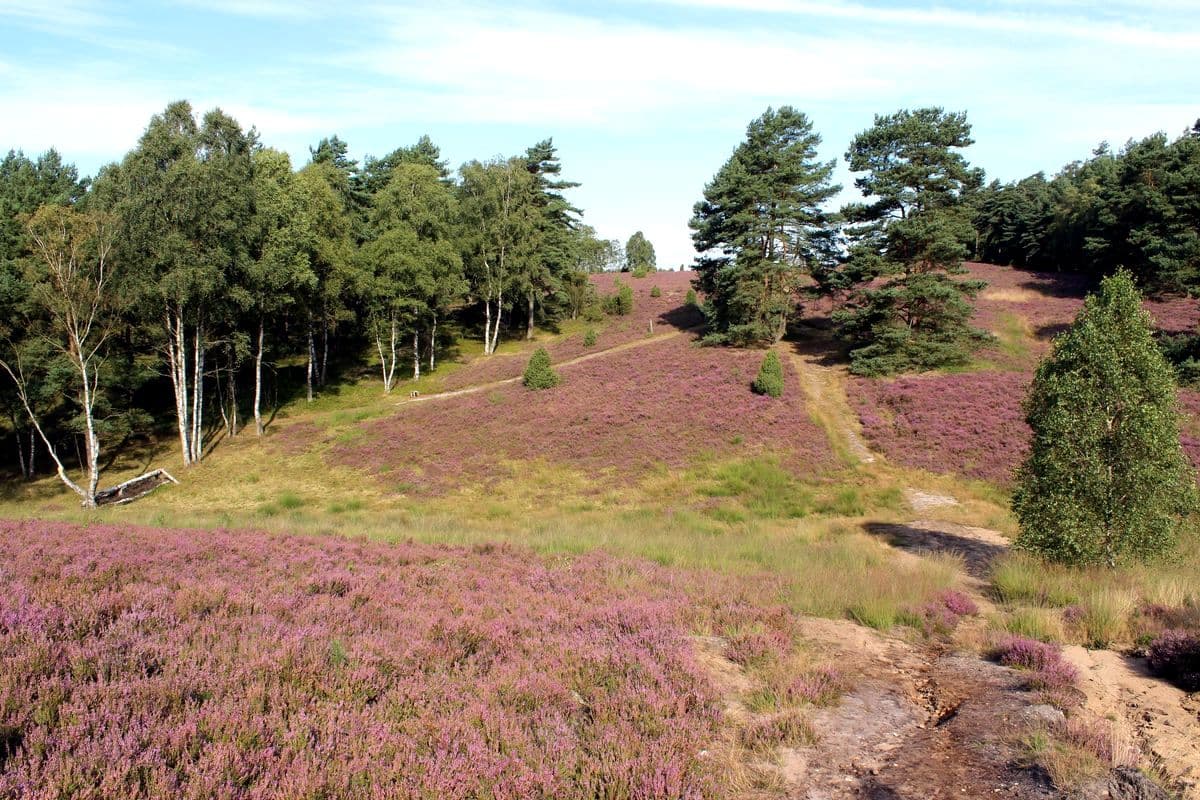
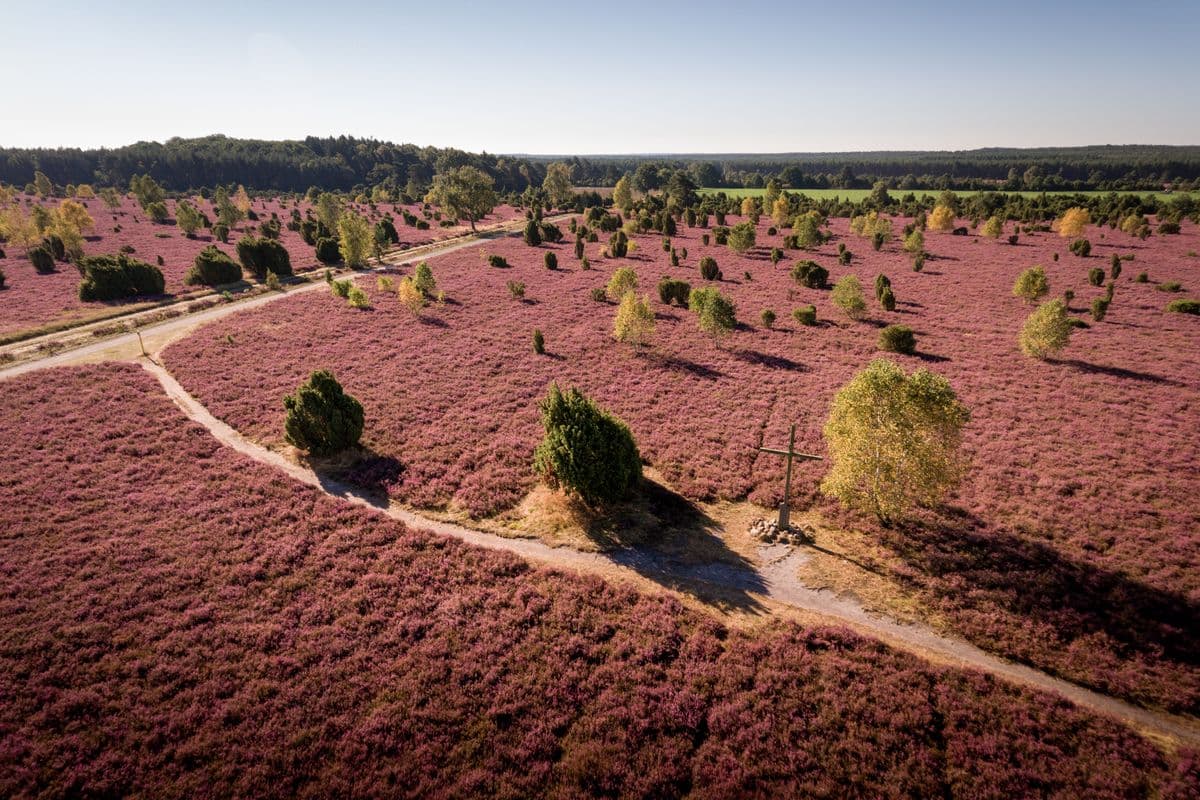
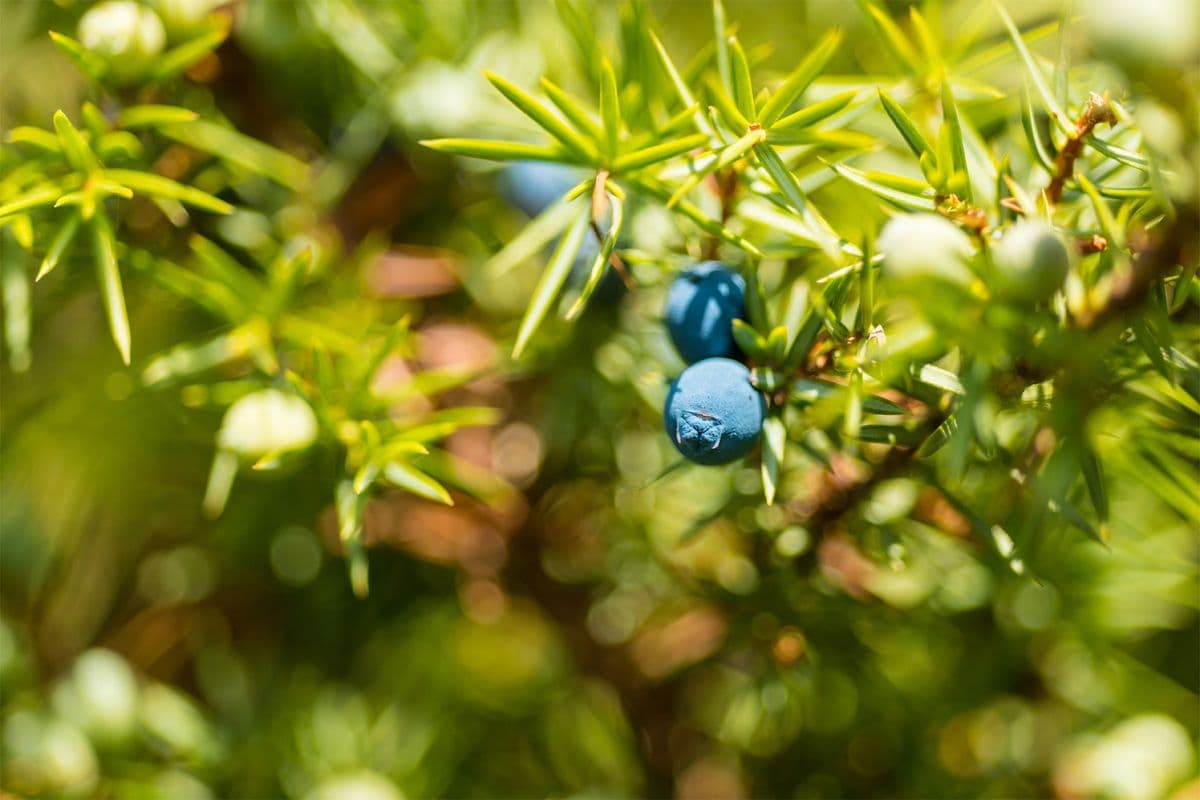
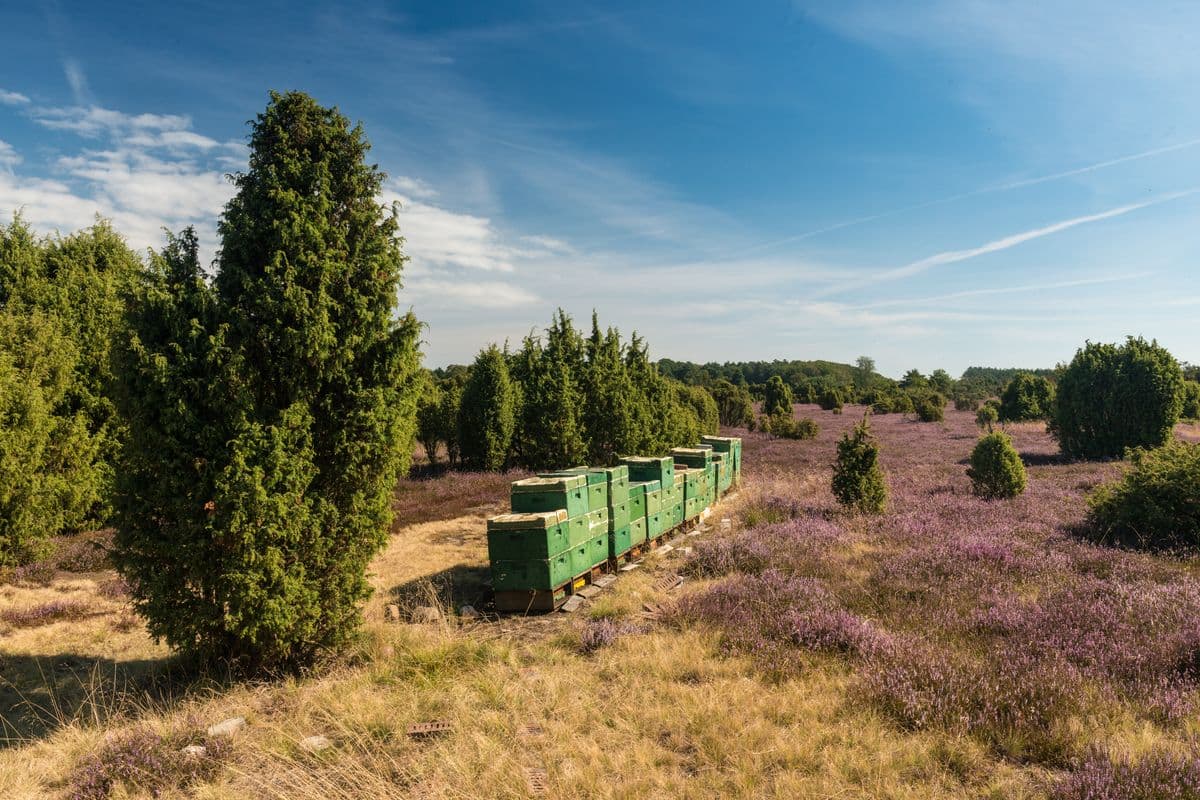
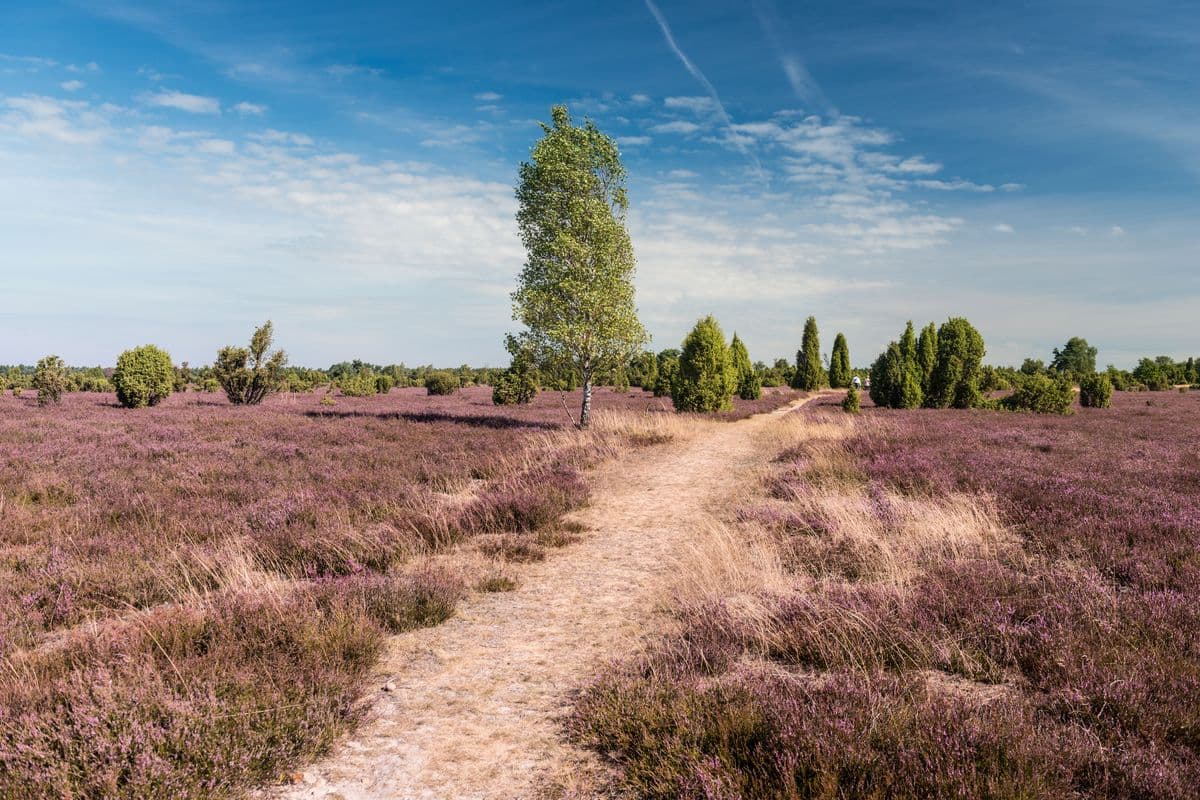
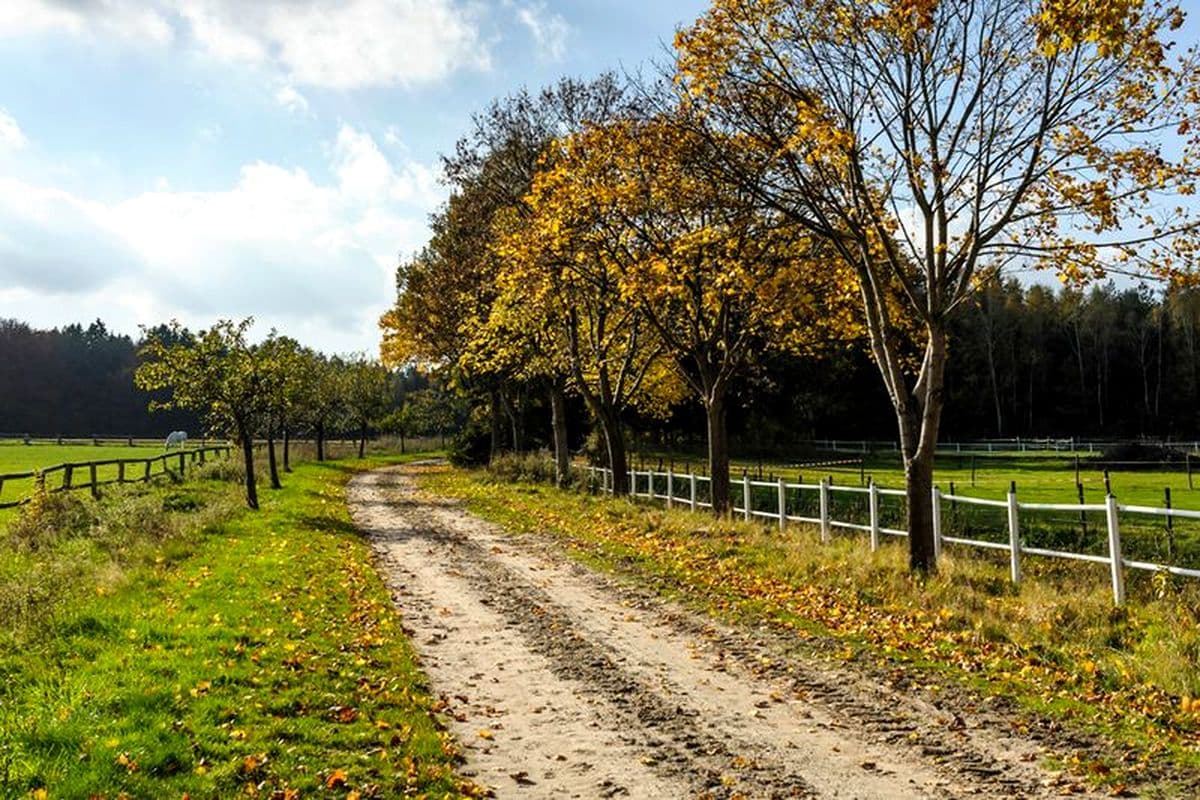
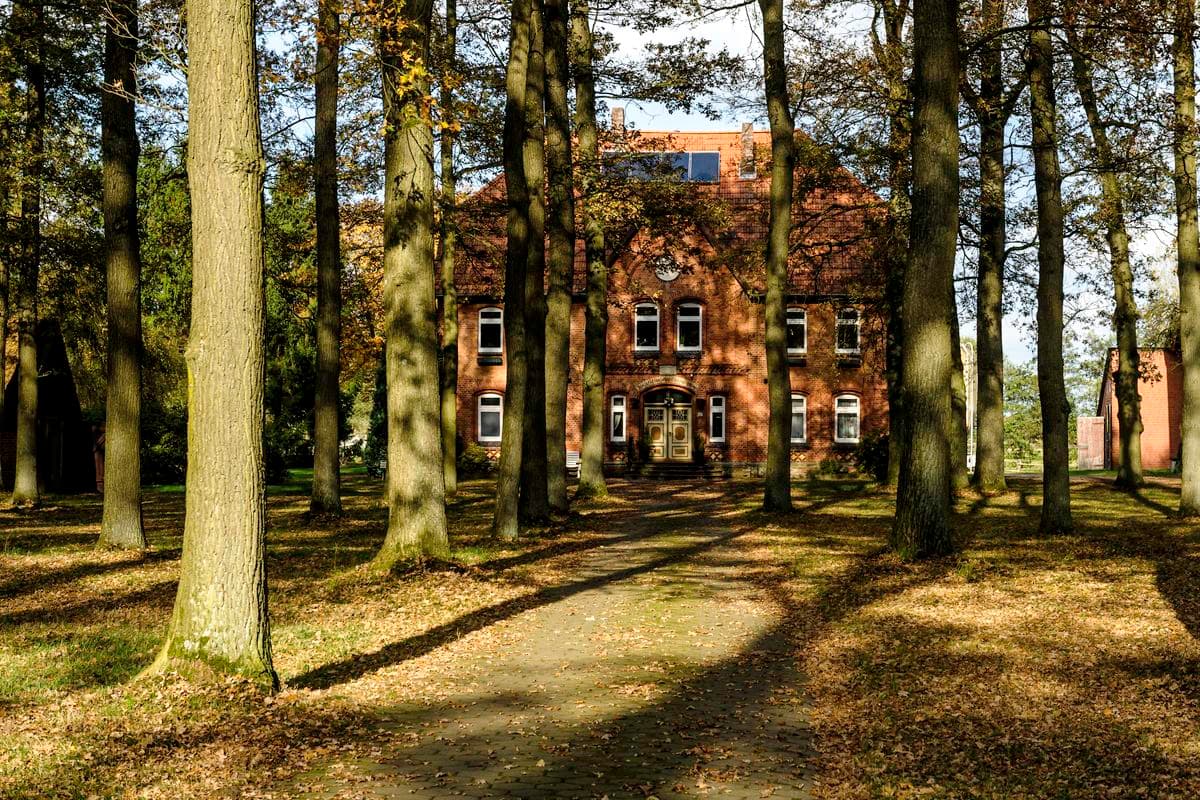
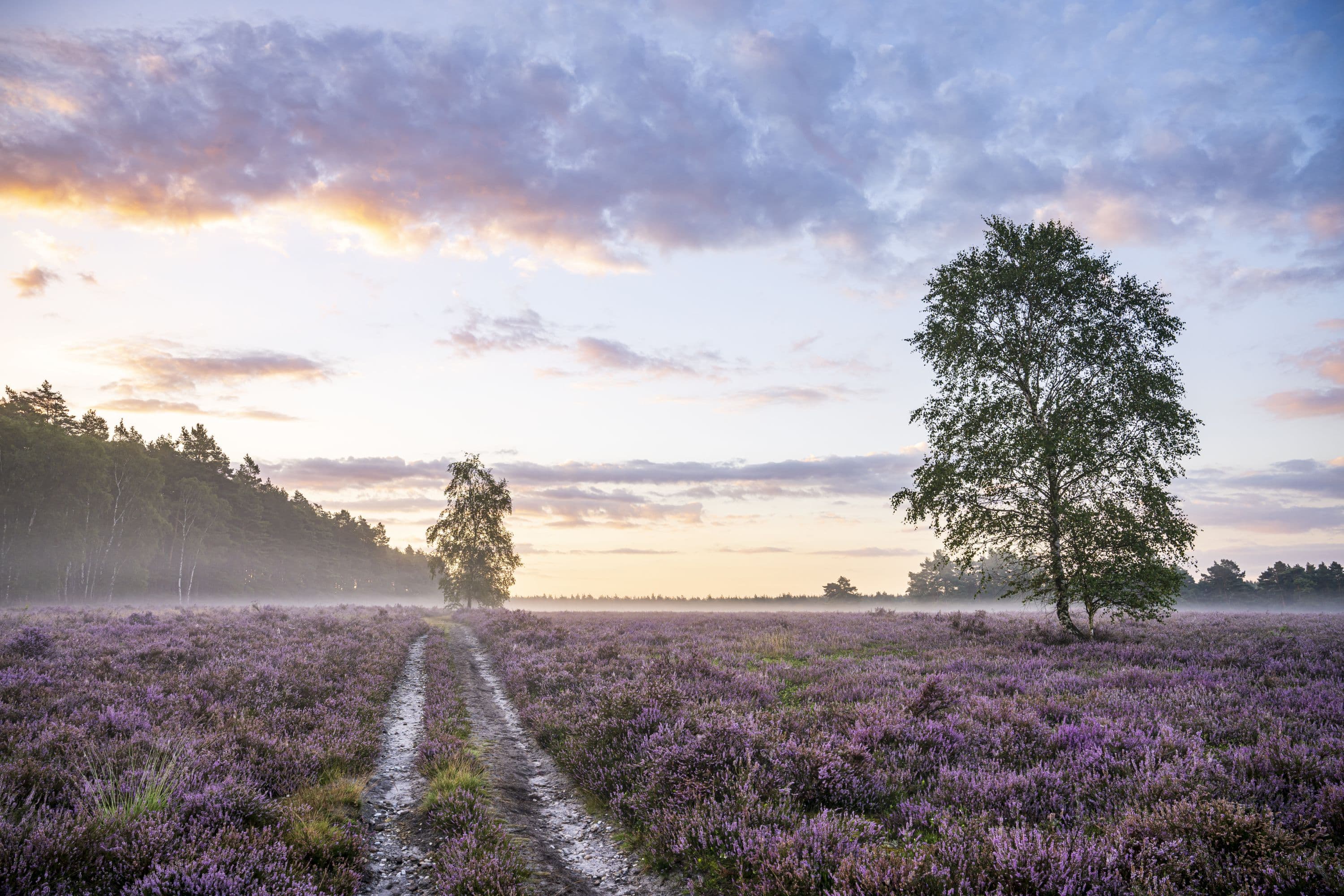
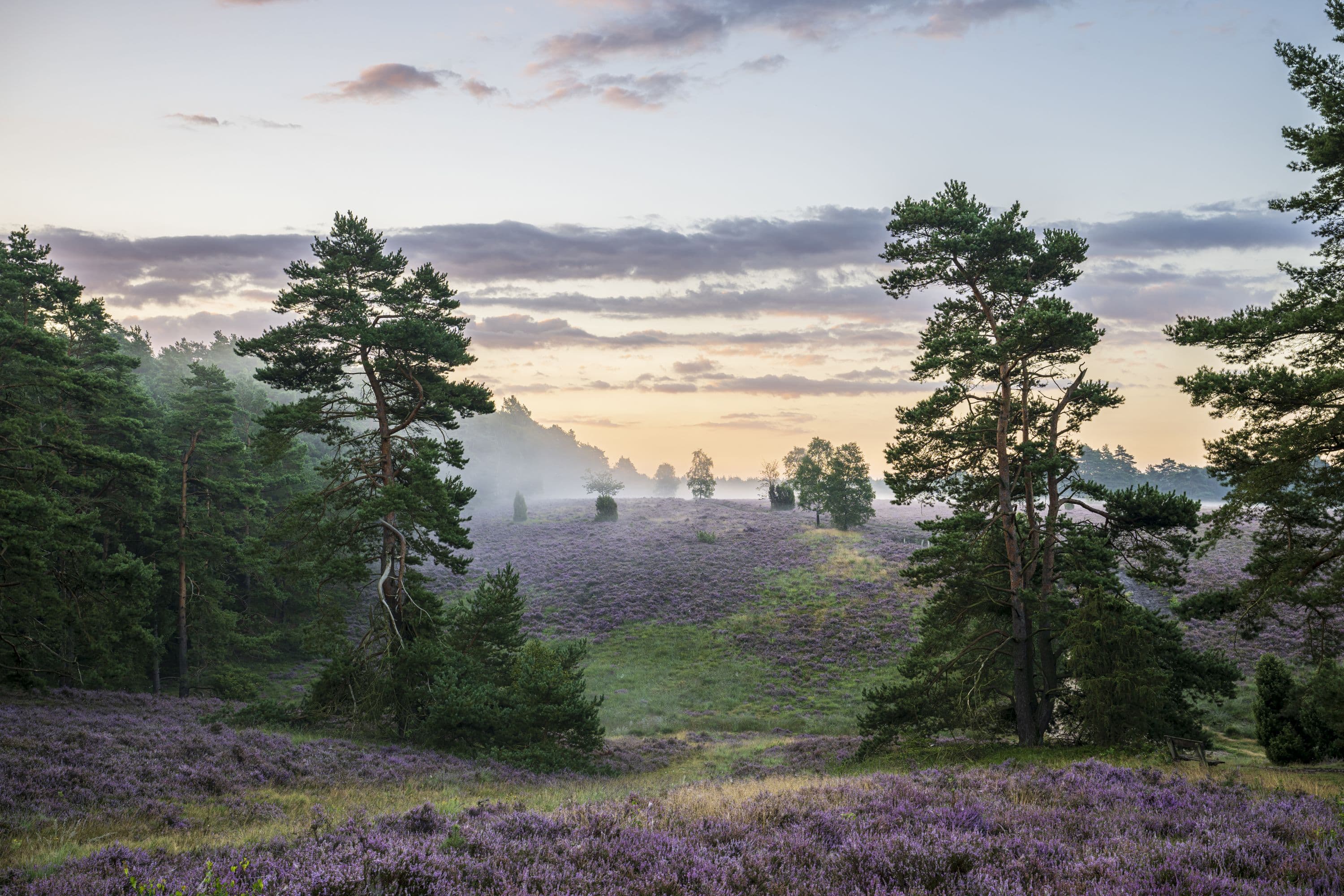
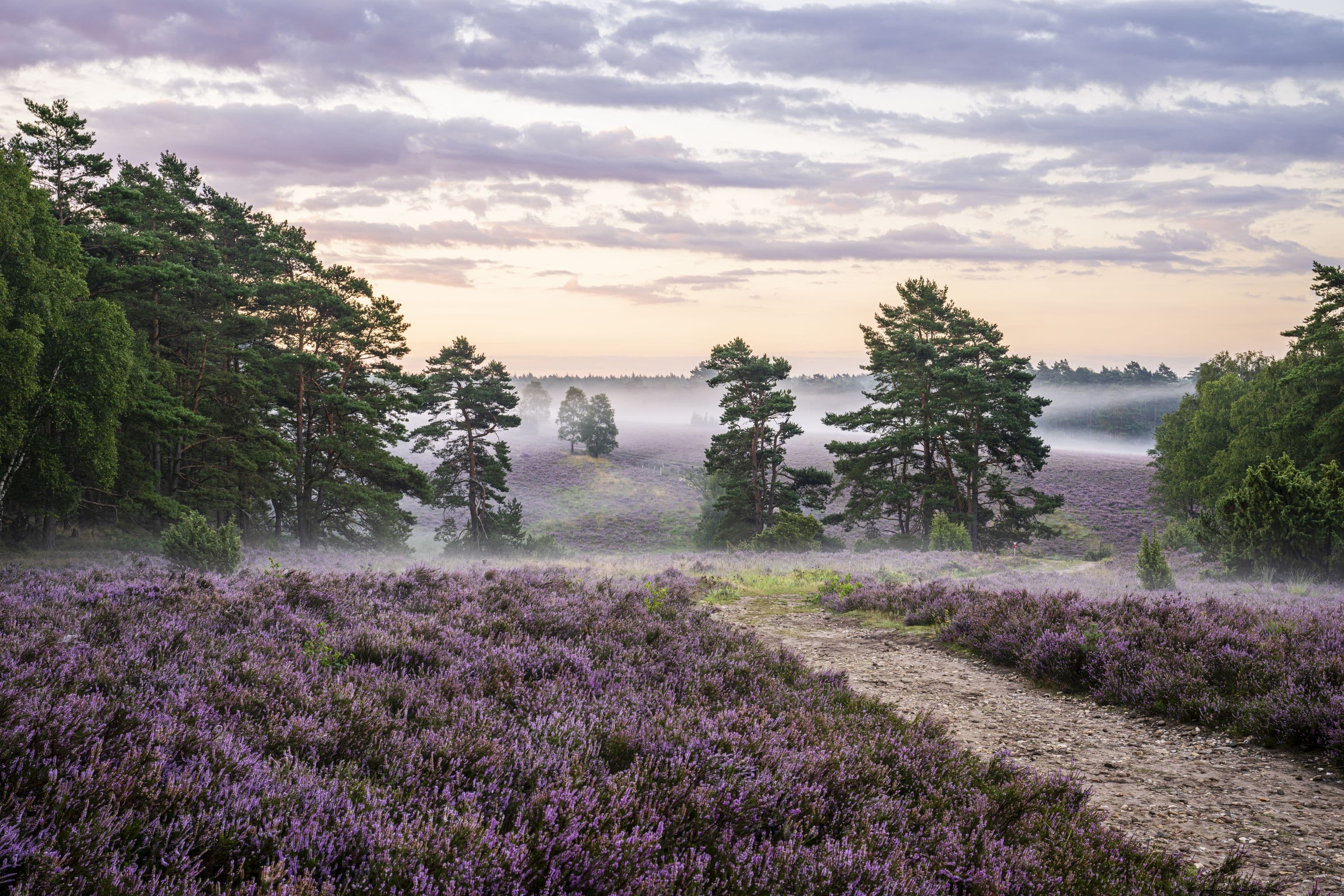
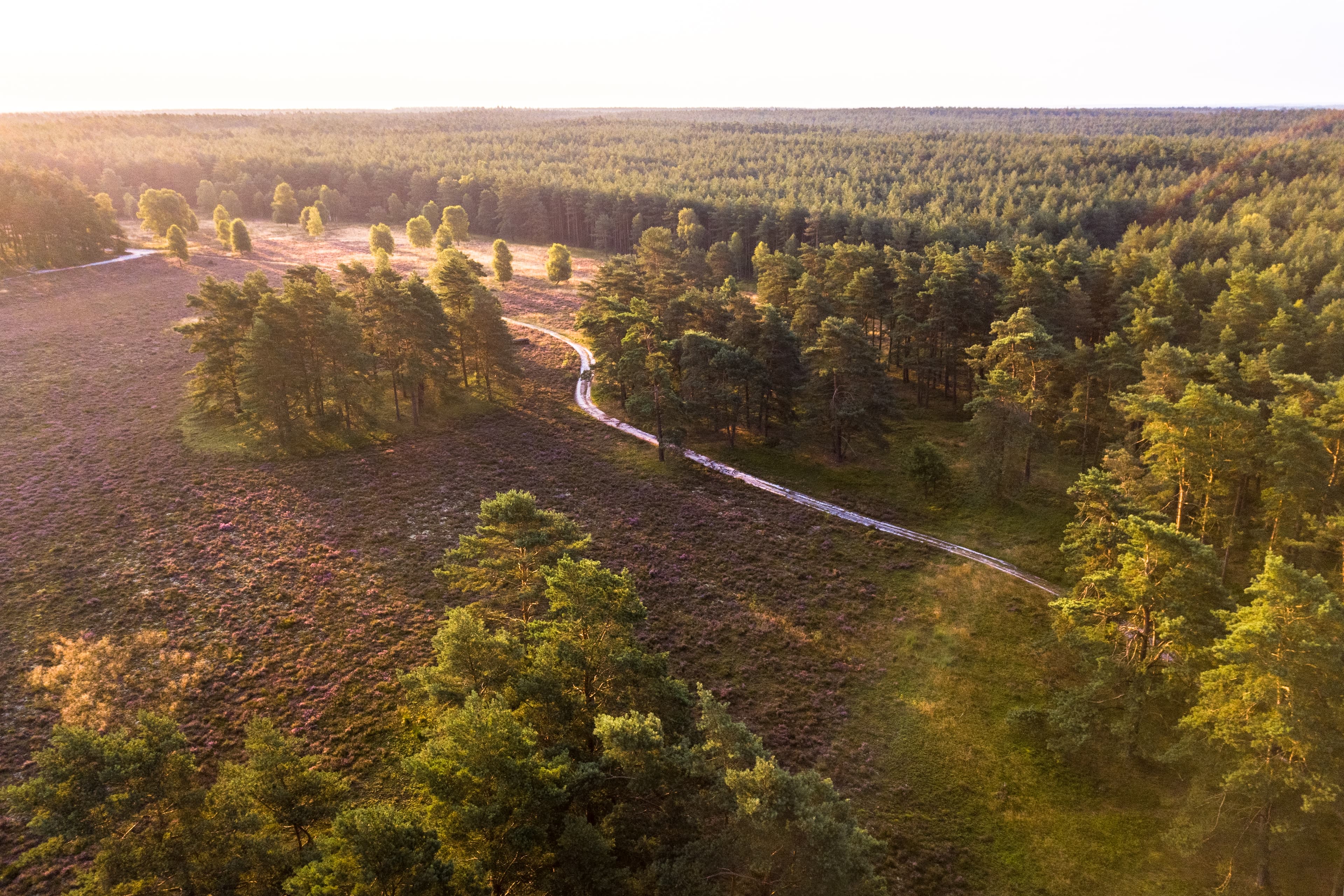
Am Wegesrand sind zahlreiche Sehenswürdigkeiten zu erkunden. Vor allem im Monat August, zur Zeit der Heideblüte, ist diese Fahrradtour in der Lüneburger Heide ein landschaftlicher Hochgenuss.
Was erwartet Sie auf diesem Radweg?
Von der Misselhorner Heide über die Große Heide, die Schmarbecker Heide und den Wacholder Wald schlägt diese 39km lange Radtour einen großen Bogen durch Faßberg und vorbei am Hausselberg. Das einzigartige Landschaftsbild wird durch sanfte Hügel, kleine Täler und herrliche Heideflächen geprägt.
Unterwegs erfahren Sie an Hand von Informationstafeln, wie die Heide- und Waldlandschaft im Laufe der Jahrhunderte entstanden ist.
Spüren und genießen Sie die Ruhe der Natur.
Verlauf des Radweges Große Heidetour
Sie starten am Parkplatz Misselhorner Heide, an dem auch der Heidepanoramaweg beginnt. Dieser macht an 10 Stationen das Besondere der alten Kulturlandschaft erlebbar. Durch einen Kiefernwald fahren Sie zum nächsten Parkplatz "Eicksberg", von hier aus ist auch das landschaftlich besonders eindrucksvolle Tiefental zu erreichen.
Weiter geht es durch Waldgebiete bis nach Lutterloh. Hinter dem Dorf führt der Weg zum Parkplatz "Schillohsberg". Gegenüber beginnt der HeideErlebnispfad Schillohsberg. Etwas weiter Richtung Osten folgt die Tour den Spuren des berühmten Mathematikers Carl Friedrich Gauß, der im 19. Jahrhundert die Anhöhen der Südheide für deine Vermessungsarbeiten nutzte.
Der Radweg führt Sie durch Kiefernwälder bis zur Oberoher Heide, eine weite und abwechslungsreiche Heidelandschaft. Danach fahren sie zum Wacholderwald, dem größten und schönsten Wacholderwald Niedersachsens. Nicht weit entfernt liegt der idyllische Heideort Schmarbeck, mit historischen Höfen und altem Eichenbestand. Hier könnten Sie die Tour abkürzen, indem Sie direkt Richtung Parkplatz „Gerdehaus“ fahren.
Die reguläre Route führt Sie nach Faßberg zur Erinnerungsstätte Luftbrücke Berlin und danach dann durch Wälder und Felder bis nach Gerdehaus an den Haußelberg. Auf einer Infotafel erfahren Sie hier Wissenswertes zu den Langobarden, die einst in dieser Gegend lebten. Auf der nächsten Etappe durchfahren Sie das Heidedorf Weesen bis nach Hermannsburg. In diesem einstigen Missionsort befindet sich ein interessantes Heimatmuseum und das Ludwig-Harms-Haus mit Ausstellungen und Weltladen.
Hintergrund-Informationen zum Radweg Große Heidetour
Wie unsere Vorfahren mit und von der Heide lebten
Auf den nährstoffarmen Böden der Lüneburger Heide wurde über Jahrhunderte die Heidebauernwirtschaft, ein landwirtschaftliches Bewirtschaftungssystem angewandt. Die Heideflächen wurden gemeinschaftlich als Weide für die Heidschnucken genutzt. Auf einigen Flächen wurden die Heideplaggen zusammen mit dem Humus abgeschlagen und als Einstreu in den Ställen genutzt. In Verbindung mit dem Kot der Tiere entstand ein wertvoller Dünger, der den nährstoffarmen Acker aufwertete und Buchweizen sowie Roggen gedeihen ließ.
"Sich abplaggen" kommt von den Heidebauern
Das Heideplaggen war eine körperlich sehr schwere Arbeit, die mit einer "Twicke" ausgeführt wurde. Dabei wurde der stark durchwurzelte Boden in ca. 4 bis 6 cm Höhe abgestochen.
Aus Heide wird Wald und zurück zur Heide
Mitte des 19. Jahrhunderts bestand die Lüneburger Heide aus riesigen Heideflächen mit einzelnen Sandblößen dazwischen. Die Waldflächen waren durch Holzeinschlag und starke Waldbeweidung fast vollständig verschwunden.
1870 wurde Mineraldünger eingeführt und die Heidebauernwirtschaft ging ihrem Ende zu, sie war nicht mehr rentabel. Die Erträge durch die Schnuckenhaltung gingen stark zurück und auch die Heidschnuckenwolle fand nur noch schlecht Absatz, die Baumwolle setzte sich immer mehr durch.
Hauptsächlich mit Kiefern wurde wieder Wald aufgeforstet und aus der Lüneburger Heide wurde ein Lüneburger Wald.
Anfang des 20. Jahrhunderts entstand erneut ein Umdenken. Viele Menschen entdeckten die Schönheit der Natur und insbesondere der Heidelandschaft. Die vereinzelt noch vorhandene einzigartige Tier- und Pflanzenwelt sowie die Reste der alten Kulturlandschaft aus der Zeit der Heidebauernwirtschaft sollten bewahrt und wieder ausgedehnt werden.
Gelungene Beispiele sind die Heidedörfer Schmarbeck, Ober- und Niederohe sowie Gerdehaus und die schönen, ausgedehnten Heideflächen am Schillohsberg und in der Misselhorner Heide.
Heute kümmern sich hauptsächlich wieder die vierbeinigen Landschaftpfleger, die Heidschnucken, um den Erhalt der Heide.
Das Wichtigste der Radtour "Große Heidetour" in Kürze
- Misselhorner Heide und Tiefental
- Heidefläche Schillohsberg
- Oberoher Heide
- schönster und größter Wacholderwald Niedersachsens
- Heidedorf Schmarbeck mit historischen Höfen
- Erinnerungsstätte Luftbrücke
- Gerdehaus am Haußelberg
- Heidebauerndorf Weesen
- Missionsort Hermannsburg
- Länge des Radweges: 39km
Tipps zur Einkehr
Zu jeder Radtour gehören Pausen, in denen Sie neue Energie tanken und sich stärken können. Neben den Picknickplätzen entlang Ihrer Tour finden Sie in Hermannsburg und in Faßberg Restaurants und Cafés, in denen Sie regionale Köstlichkeiten genießen können. So zum Beispiel das Restaurant "Im Wiesengrund" oder das "Gut Landliebe" in Weesen. In Hermannsburg erwartet Sie das Restaurant Candace im Ludwig-Harms-Haus, Ohlendorfs Gasthaus oder das Restaurant "Gänsestuben" im Misselhorner Hof mit regionalen Spezialitäten.
Service-Hinweis
Unterwegs befinden sich Fahrrad-Reparaturstationen am Rathaus Hermannsburg (Am Markt 3, 29320 Hermannsburg), am Rathaus Faßberg (Große Hauptstraße 40 – 44, 29328 Faßberg) sowie am Parkplatz Misselhorner Heide, 29320 Hermannsburg.
Streckenprofil Radweg
Überwiegend asphaltierte Wirtschaftswege, Radwege, befestigter Radwanderweg von Oberohe zum Wacholderwald und kurze Teilstücke auf unbefestigten Waldwegen mit sandigen Abschnitten
Ausgangspunkt
Parkplatz "Misselhorner Heide"
Position: Position: N52.823210 E10.136225
Ausstattung: Sitzgruppe mit Tisch, WC, barrierefreies WC, Fahrradbügel
Anfahrtsbeschreibung: Den Parkplatz Misselhorner Heide erreichen Sie über die K 17 Hermannsburg Richtung Unterlüß. Ca. 1,5 km nach Ortsausgang Hermannsburg liegt rechts der Parkplatz. Der Parkplatz ist mit dem Hinweis "Misselhorner Heide" ausgeschildert.
Sie erreichen den Parkplatz „Misselhorner Heide“ auch mit dem örtlichen Beförderungsunternehmen CeBus Linie 260 und dem Bürgerbus Südheide aus Richtung Hermannsburg und Unterlüß. Die Haltestelle befindet sich beim Gasthof Misselhorner Hof. Von dort aus gehen Sie an der K 17 entlang ca. 15 Min. (1,1 km) in Richtung Unterlüß. Fahrzeiten und weitere Verbindungen entnehmen Sie bitte der Reiseauskunft der Deutschen Bahn.
Weitere Informationen und Tipps zu den Radtouren in der Südheide finden Sie auch im Region Celle Navigator.

